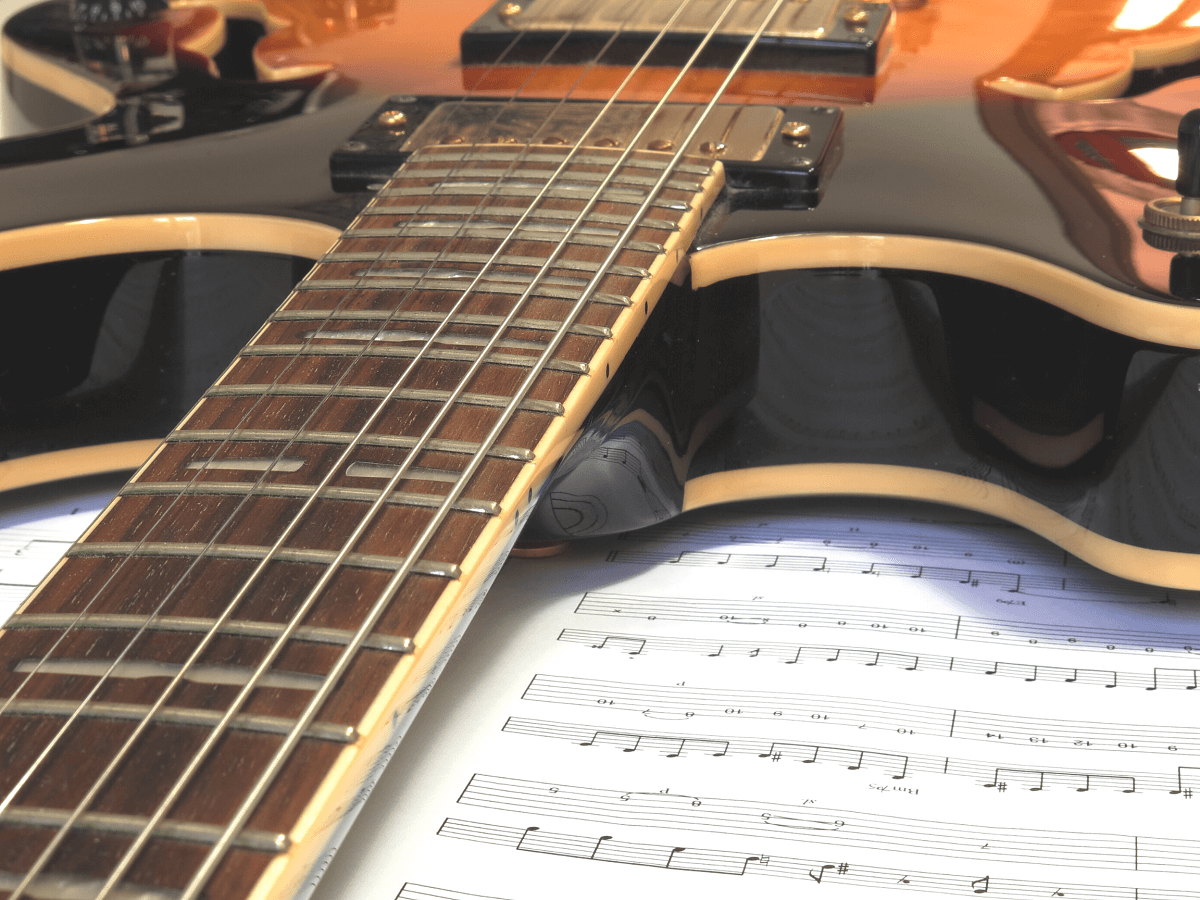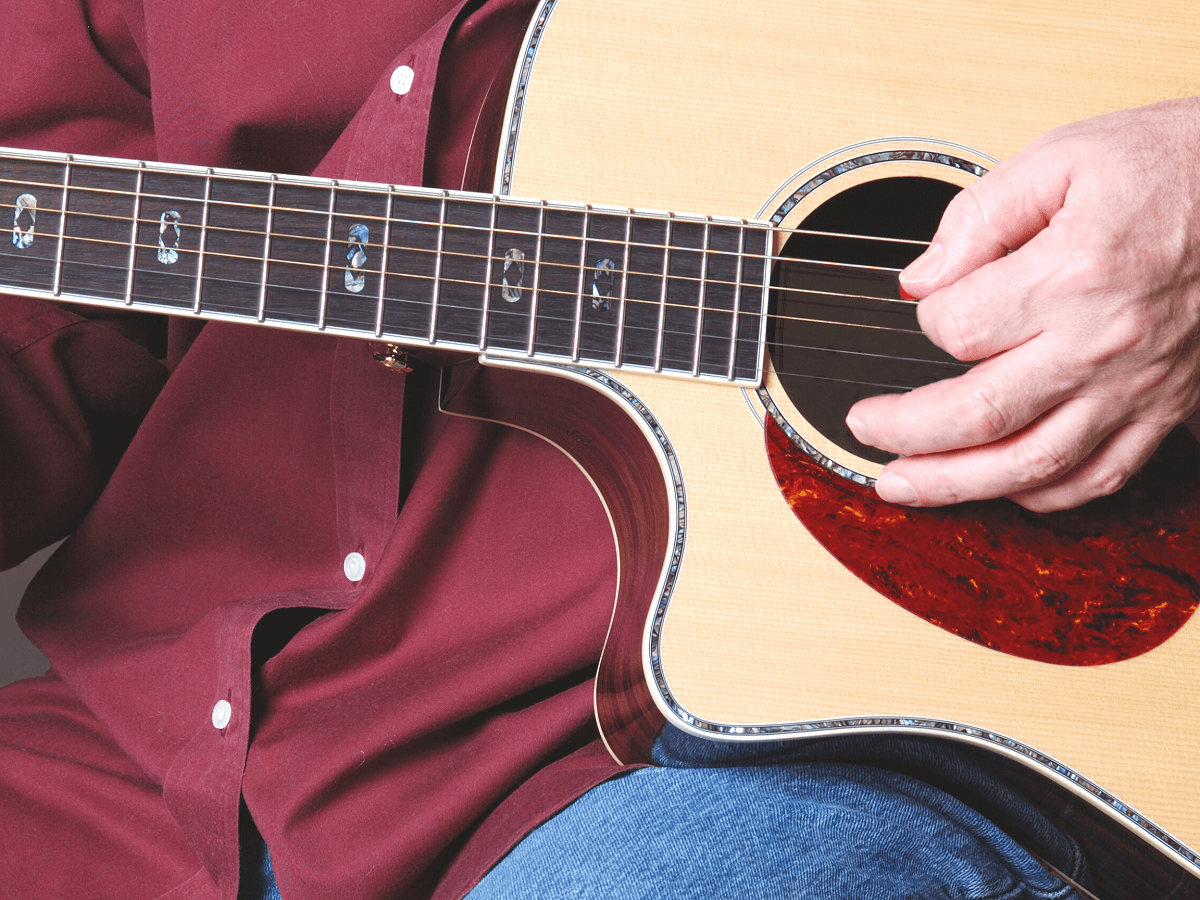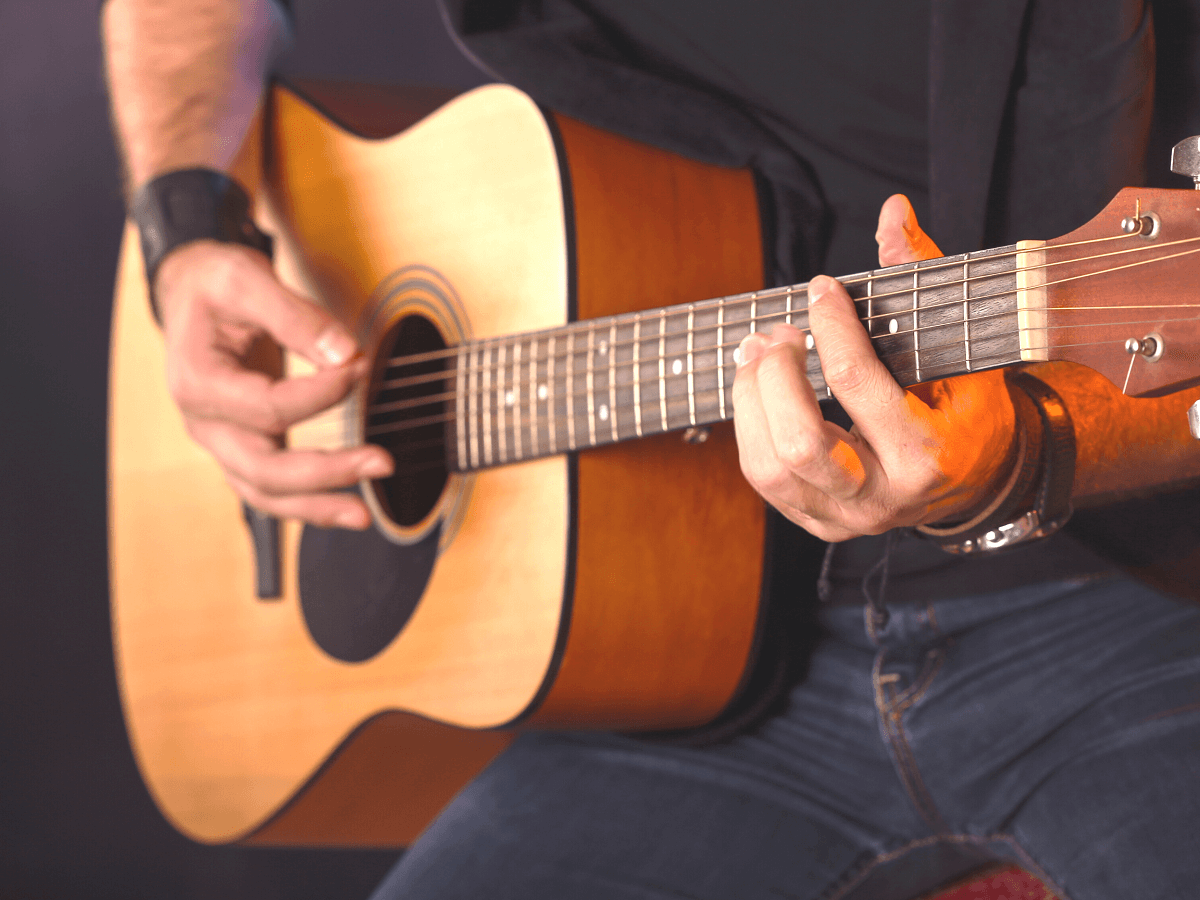Whether you’re an experienced musician, a beginner, or simply a jazz music enthusiast, having the right acoustic guitar can significantly enhance your sound quality and overall experience.
This tool is not only great for producing exceptional jazz tunes, but it also enriches your practice sessions and live performances.
With the vast array of acoustic guitars available in the market, choosing one for jazz music can be quite daunting.
The focus should be on factors such as sound quality, playability, durability, and design.
The aim of this guide is to help you make an informed decision when you next guitar purchase.
The key to excelling in jazz music could just be finding the guitar that perfectly fits your needs.
Table of Contents
- Best Acoustic Guitars For Jazz Music
- Martin 000-28 Eric Clapton Signature Auditorium Acoustic Guitar
- Taylor 214ce Grand Auditorium Acoustic Guitar
- Squier SA-150 Dreadnought Acoustic Guitar
- Martin D-45 Natural Acoustic Guitar
- Blueridge BR-143CE Acoustic-Electric Guitar
- Taylor T5z Classic Acoustic-Electric Guitar
- Takamine Pro Series 3 New Yorker Acoustic-Electric Guitar
- Godin A6 Ultra Natural Electro-Acoustic Guitar
- Eastman DM1 Gypsy Jazz Guitar Natural Acoustic Guitar
- Fender FA-115 Dreadnought Acoustic Guitar
- D’Angelico Premier Tammany LS Acoustic-Electric Guitar
- Sheeran By Lowden S03 Acoustic Guitar
- Godin 5th Avenue Kingpin P90 Jazz-Style Acoustic-Electric Guitar
- Blueridge Guitars BR-341 Acoustic Guitar
- Gretsch G100CE Synchromatic Cutaway Acoustic-Electric Guitar
- What Makes a Good Acoustic Guitar for Jazz Music?
- What Are Typical Features in a Jazz Acoustic Guitar?
- How to Choose the Right Acoustic Guitar for Jazz?
- What Wood Type Is Best for Jazz Acoustic Guitars?
- Should You Opt for Steel or Nylon Strings for Jazz?
- How Does Body Shape Affect the Sound of a Jazz Guitar?
- How Important Is the Neck Size of a Jazz Acoustic Guitar?
- What Is the Role of a Guitar’s Cutaway in Jazz Music?
- How Does Size Affect the Sound of Acoustic Jazz Guitars?
- How Does a Guitar’s Bracing Pattern Impact Its Jazz Sound?
- The Bottom Line
Best Acoustic Guitars For Jazz Music
Before I begin, here are my top selected choices:
|
|
Squier SA-150 Dreadnought Acoustic Guitar

Dreadnought guitar with big sound, ideal for beginners. Check Price
|
Squier SA-150 Dreadnought Acoustic Guitar

Dreadnought guitar with big sound, ideal for beginners.
Check Price
|
Martin 000-28 Eric Clapton Signature Auditorium Acoustic Guitar
Handcrafted with premium materials for delicate tones.
This is a handcrafted acoustic guitar made with a premium East Indian rosewood back and sides and a Sitka spruce top. Its small 000 body size and short scale produce delicate, balanced tones, combined with stylish features like abalone pearl inlays on the ebony fingerboard and Eric Clapton’s signature in mother-of-pearl between the 19th and 20th frets. The guitar includes a lifetime warranty and a deluxe Martin hardshell case.
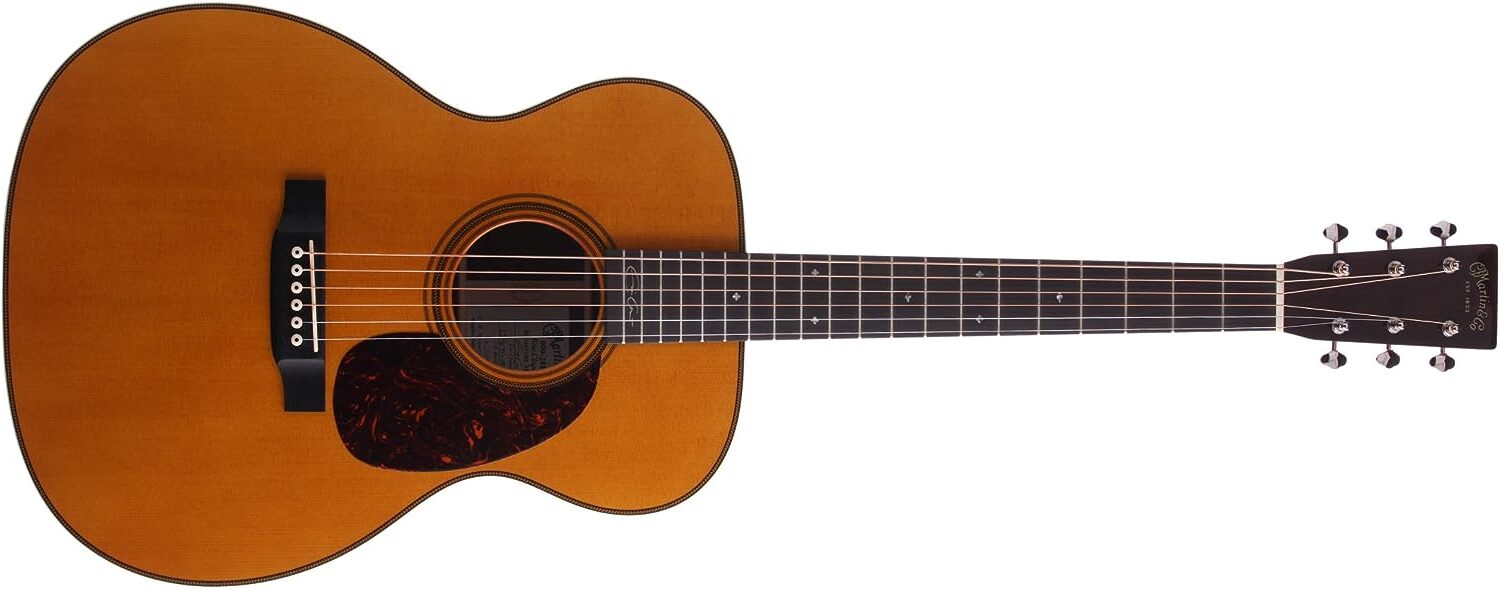
The Martin 000-28 Eric Clapton Signature is a spectacular auditorium acoustic guitar designed in a natural color tone.
It boasts a robust and intricate construction with its dovetail neck joint and mahogany blocks.
The guitar also showcases a high-quality select hardwood material used for the neck and a sturdy diamond square-tapered headstock.
Its design features 20 frets in total and comes with a 533E Geib style case for safekeeping.
Renowned guitar makers, Martin have made the product using a top material type of Spruce, which accompanies the body material made from Rosewood.
Furthermore, the back of the guitar is also fashioned out of rosewood, with the neck material and fretboard both made out of wood and ebony wood respectively.
A unique feature is its string material type which is composed of nickel and the guitar being designed for right-handed orientation.
Additionally, it provides an adjustable guitar bridge system.
The guitar stands out with its classic look, complete with a herringbone wood marquetry soundboard and rosette, and a body that is bound with grained ivoroid.
The unique long diamond-and-square pattern inlaid with abalone pearl on the ebony fingerboard adds to the premium look of the guitar.
The Eric Clapton Signature Acoustic Guitar is also tastefully equipped with a hand-beveled tortoise pickguard and nickel-plated, open-geared machines fitted with unique butterbean knobs.
It also features individually numbered interior labels, which come packaged with a limited lifetime warranty and deluxe Martin hardshell case.
- My Review
After playing this Martin 000-28 Eric Clapton Signature Auditorium Acoustic Guitar, I feel that it truly honors the legendary musician’s name.
The smooth mahogany construction and dovetail neck joint are meticulously crafted, resulting in a robust and sturdy instrument.
It boasts an eye-catching select hardwood neck with a solid headstock that has a diamond-square taper, delivering a tasteful aesthetic.
With this guitar, you’ll have access to 20 frets, which is the standard for an acoustic guitar, offering a full tonal spectrum.
One of the standout features of this guitar, in my opinion, is the material selection for its anatomy.
The body is made of rosewood, known for its rich and deep tonal qualities.
Equipped with an ebony fretboard and a nickel string, this guitar features delicate, balanced tones that resonate beautifully no matter what style of music you’re into.
When you look at the color palette, Natural is a perfect shade in capturing the vibrant essence of a well-crafted acoustic guitar.
Its hand orientation is for right-handed users, which is the standard, but keep in mind if you’re a leftie.
I found the adjustable guitar bridge system to be particularly helpful, as it allows for precision when it comes to the action of the guitar.
Playing on this guitar, I noticed the solid Sitka spruce top and the solid East Indian rosewood back and sides contribute to its wonderful vintage tone.
This guitar’s smaller body size and shorter than standard scale help produce a softer sound, making it versatile for both strumming and fingerpicking alike.
The bound body of this guitar adds more to its elegance, while its ebony fingerboard supports smooth playstyle.
I was impressed by how the instrument’s herringbone wood marquetry complements the body’s grained ivoroid binding, giving it a refined finish.
The long diamonds-and-squares pattern in abalone pearl on the fretboard is visually appealing and adds depth to the design.
Also, an essential part of this guitar’s charm is the Eric Clapton signature inlaid between the 19th and 20th frets in mother-of-pearl, which adds a unique touch.
Not to mention, it’s equipped with nickel-plated open-geared machines with unique butterbean knobs that are as practical as they are stylish.
In my experience, the Martin 000-28 Eric Clapton Signature Auditorium Acoustic Guitar is a brilliant rendition of an acoustic, classical guitar with a comfortable fretboard, a beautiful selection of wood, and an exceptional tonal quality.
- Pros:
- Rich and full-tone sound.
- Comfortable V-shape neck.
- High build and material quality.
- Cons:
- Neck shape may not suit everyone.
- High end, thus expensive.
My final verdict is that the Martin 000-28 Eric Clapton Signature Auditorium Acoustic Guitar Natural is simply a work of art.
Its Mahogany Construction and Select Hardwood neck provide truly high-end features.
The combination of the guitar’s Sitka spruce top along with its rosewood back and sides delivers a sound that is both delicate and balanced.
While the pricing might be steep for some, I can convincingly say this guitar is worth every penny for its superior tonal quality and meticulous craftsmanship.
It’s a fantastic investment especially considering it comes with a Martin Deluxe Molded Hardshell Case.
Taylor 214ce Grand Auditorium Acoustic Guitar
Versatile guitar with vibrant highs, warm lows.
The guitar’s layered Indian Rosewood back and sides, along with a solid Sitka spruce top, produce vibrant highs and a resonant, warm low end, making the instrument versatile. Its structure includes a Venetian cutaway design for enhanced finger reach, and ES2 electronics for clean, amplified tone. It also comes with a sturdy padded gig bag for protection.
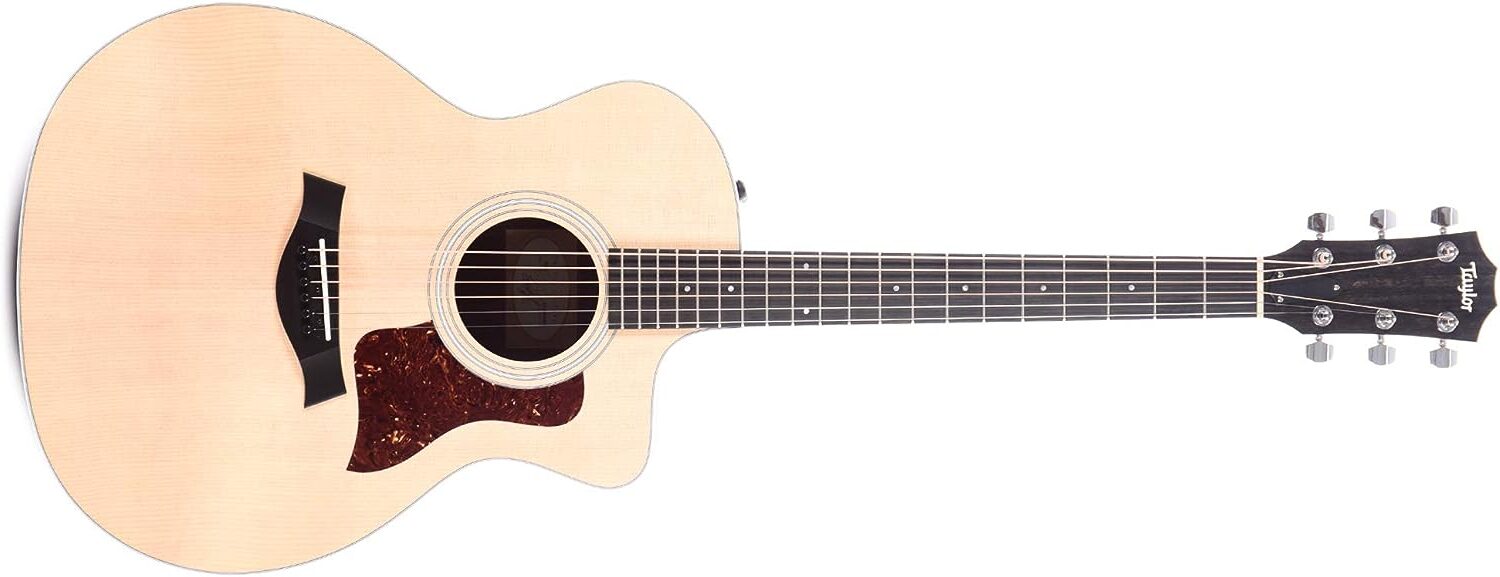
This guitar is a creation of the renowned brand, Taylor.
It exhibits a striking grand auditorium shape that’s named the 214ce.
Adorned in a natural color, the guitar boasts a top made from high-grade Sitka Spruce Wood.
The back and sides of the guitar body are crafted with finely layered Indian Rosewood, concealing powerful and resonant tones.
Its neck is made with tropical mahogany, a beautiful and durable choice that complements the strong, robust nature of the West African Ebony Fretboard.
The guitar’s sound is brought to life by the strings, which are made from Phosphor Bronze.
Designed for right-handed orientation, this gem also features a fixed guitar bridge system.
If you’re looking to take full control over your playing, you will appreciate the Venetian cutaway – this grants an easy access to higher notes.
To top it off, the Taylor 214ce comes with ES2 electronics for amplified situations, and a gig bag that ticks the boxes on sturdiness and padding.
Lastly, unique characteristics such as the Black Plastic Truss Rod Cover, the creamy white Heel Cap Binding, and the 4mm Dot Italian Acrylic Fretboard Inlay, all contribute to the guitar’s unique aesthetic and distinct identity.
- My Review
The Taylor 214ce Grand Auditorium has made a solid impression on me for several reasons.
First off, the beauty of the guitar cannot be overlooked; it’s both attractive and functional.
Its body, made of layered Indian rosewood, and a top of Sitka spruce create a vibrant high and resonant, warm low tone.
With layering, the rosewood forms a unique sound that is quite distinctive and pleasing to the ears.
It feels as though this guitar can handle anything from powerful chords to subtle styles such as flatpicking or fingerpicking.
However, what stands out in its build is the forward shifted pattern bracing which enhances the resonant nature of the wood, giving it a loud and full acoustic tone.
Beyond its superior sound, the playability of the 214ce is remarkable.
The action is low, which is great for those with smaller fingers, and the neck width is comfortable, not too wide, and not too narrow.
Playing the guitar feels smooth, and the strings, made from phosphor bronze, produce a steady, uncompromised sound.
Besides, you will hardly ever find it out of tune, which eliminates frequent disruptions during performance or practice sessions.
Additionally, the Taylor 214ce comes with ES2 electronics that serve you well in amplified situations giving you an organic, clean tone.
However, there is one concern I encountered with the guitar.
I found a number of beads inside the guitar.
This is not something you would expect from a well-established brand like Taylor, and it can be quite distracting.
Nonetheless, I must say that the disappointment this caused was leveled up by their provision of a sturdy padded gig bag.
In spite of this minor concern, the Taylor 214ce Grand Auditorium managed to still feel special and worthy of its brand name.
Not only does it look appealing to the eyes, but it also plays wonderfully making every strumming and plucking feel like an out of body experience.
Taken together, if you’re passionate about making music and playing a guitar, you should seriously consider the Taylor 214ce Grand Auditorium.
It will not disappoint you, but instead provide same level of satisfaction that it has provided me.
- Pros:
- Beautiful design and spectacular sound.
- Low action, suitable for smaller hands.
- Comes with a sturdy padded gig bag.
- Cons:
- Poor sound quality in some cases.
- Return shipment fees may apply.
- Potential quality control issues.
My final verdict is that the Taylor 214ce Grand Auditorium Sitka/Rosewood Natural ES2 w/Gig Bag is a fantastic guitar for all skill levels.
Its versatility in style and tone makes it a great all-rounder, complemented by the superb build quality typical of the Taylor brand.
The accompanying gig bag and ES2 electronics enhance its value, making it an excellent choice for gigging musicians or those who often travel with their instrument.
Though not the cheapest guitar out there, its exceptional sound, playability, and durability justify its higher price point.
If you’re looking for a high-performing guitar that will truly last, you cannot go wrong with this Taylor 214ce model.
Squier SA-150 Dreadnought Acoustic Guitar
Dreadnought guitar with big sound, ideal for beginners.
This durable full-size guitar, designed by renowned musical instrument company Fender, features a traditional dreadnought body for excellent tonal balance. Its easy-to-play, slim neck makes it ideal for beginners, perfect for those playing folk, country, or blues. The all-laminate construction combines lindenwood top with mahogany back and sides, ensuring robust construction for daily use.
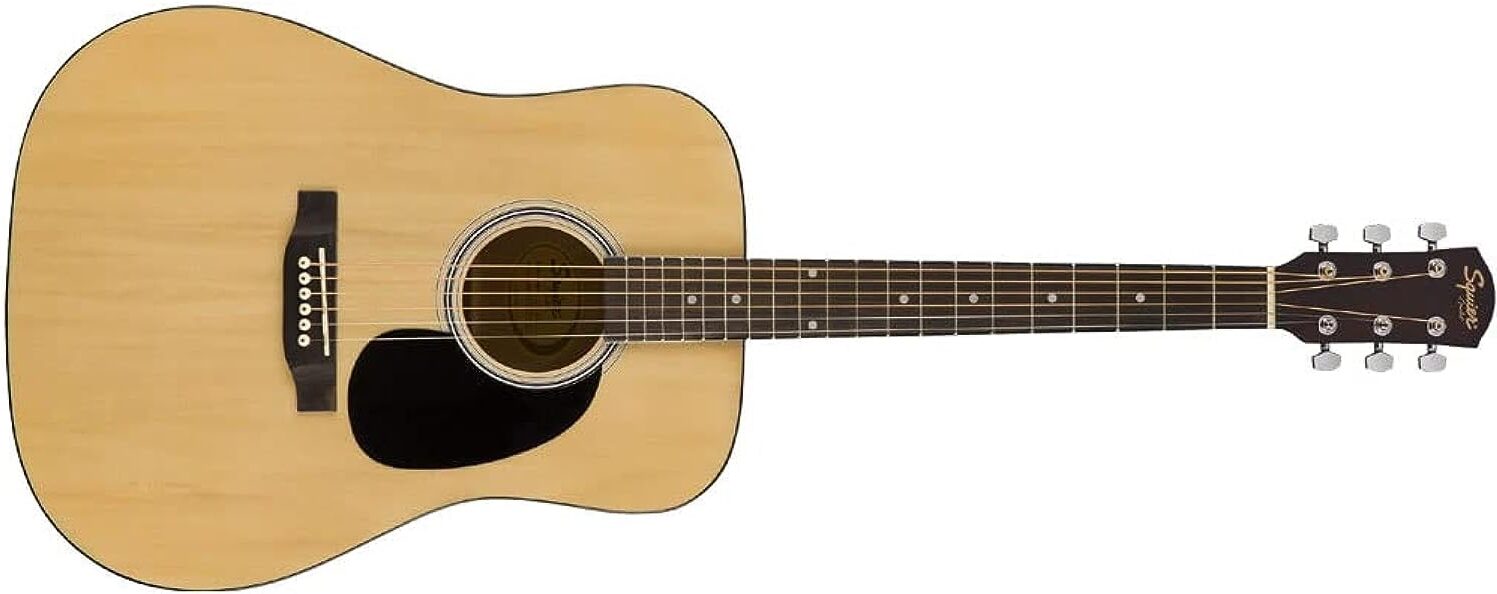
Consider the Squier SA-150 Dreadnought Acoustic Guitar in natural color – it’s great for those just starting their music journey.
Its slender neck design is great for novices, making playing easy and comfortable.
The guitar is strung with steel, the choice material for folk, country, and blues genres.
Coming from the reliable Fender brand, this instrument bears the mark of trusted craftsmanship.
A significant feature is the traditional dreadnought body shape, known for its superior tonal balance and projection.
With regards to its construction, it’s crafted out of a mixture of maple wood, basswood, and mahogany, lending it a rich and vibrant sound.
Its piezoelectric pickup configuration and alloy steel strings contribute to its distinctive sound profile.
Geared towards the right-handed player, it also features a durable dark-stained maple fingerboard and a mahogany neck.
It’s worth mentioning that the full-bodied sound and strength of this guitar is due to its all-laminate build with a top made from lindenwood, and back and sides of mahogany.
The Squier SA-150 isn’t just an instrument, it’s a fine piece of craft that’s as pleasing to the eye as it is to the ear.
- My Review
Exploring the features of this Squier SA-150 Dreadnought acoustic guitar, I was immediately charmed by the slim and easy-to-play neck shape.
Made perfect for beginners like me, its design makes the whole process of learning and playing quite effortless and fun.
The choice of steel string in this guitar does not go unnoticed, particularly since it aligns traditionally with the distinct sounds of folk, country, and blues music.
What gives me a rush of confidence in this instrument is the fact that it’s designed by Fender, a name that’s considered one of the most trusted and recognized in the musical industry.
The dreadnought body shape of this guitar enhances its tonal balance and projection, rendering an excellent sound output every time I play.
Going over the material composition, I find it interesting that the guitar’s top material type is a composite of maple wood, basswood, and mahogany wood.
It endows the guitar with a solid and durable feel, while also contributing a unique resonance to generate remarkable sound.
With a basswood body and maple wood and mahogany for its back, the guitar is both lightweight and sturdy, thus perfectly serving the needs of any beginner guitarist.
I also appreciate the right hand orientation, fitting well into my style of playing, and making the experience more comfortable.
What personally stood out to me about this guitar is the all-laminate construction which serves as a testament to its durability and resilience.
It’s the strong backbone I need to endure the daily experimental play and the harsh treatment I might sometimes subject it to as a starting musician.
The guitar’s full-bodied dreadnought tone and its slim, easy-to-play neck make it an ideal choice, and I must say, I indeed enjoy playing it every single day.
Also, the piezoelectric pickup configuration and the alloy steel strings make sure that the sound quality isn’t compromised, offering crisp, deep and rich tones.
Some features that I found needed improvement include the fit and finish of the guitar, which did not meet my personal standards.
The tuning pegs alignment seemed off and I experienced uneven string tension.
Although the sound is okay, the quality doesn’t exactly match up to my expectations from a Squier product.
However, despite these shortcomings, I believe with proper care, this guitar can be a great start for any newbies to the world of music.
- Pros:
- Great sound for its price.
- Stays in tune well.
- Ideal for beginners.
- Cons:
- Possible quality control issues.
- Tuning pegs may rattle.
- No strap connector included.
My final verdict is that the Squier SA-150 Dreadnought Acoustic Guitar offers great value for its price.
Its quality construction including maple, basswood, and mahogany wood, allows for durability and a pleasing aesthetic.
Coupled with a slim, easy-to-play neck and strong sound projection, this guitar stands as a suitable choice for beginners.
The fact that it’s designed by Fender, a well-known and trusted brand in the music industry, further boosts its credibility.
Whether you’re a novice player or experienced strummer on a budget, the Squier SA-150 Acoustic Guitar is a investment worth consideration.
Martin D-45 Natural Acoustic Guitar
High-quality materials meet elegant design in D-45.
This revamped Martin guitar boasts East Indian rosewood for the back and sides plus spruce scalloped bracing. Its fresh design features new forward shifted scalloped X bracing, open gear tuners, and an aging toner top finish. A mix of elegance and performance, it caters to right-handed players and comes with six strings.
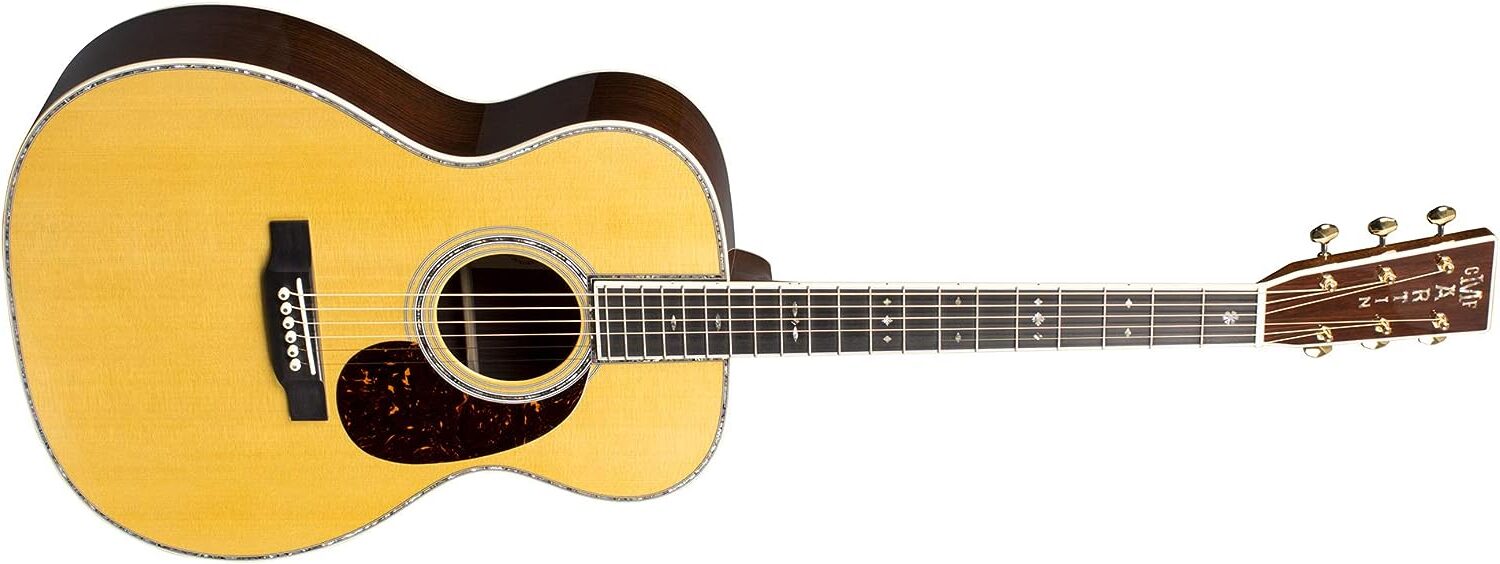
What I have here is the highly notable Martin D-45 Natural, a beautiful guitar from the well-established brand Martin.
This signature instrument stands out for its top-grade materials, majorly composed of rosewood from top to bottom.
From the top, back, to the body, and even the neck, rosewood is the primary material, providing the guitar with a unique resonance and aesthetic.
The fretboard of the Martin D-45 Natural is also designed with rosewood, ensuring its durability and robustness.
The instrument is tailored for right-handed users and features six strings, typical of any standard guitar.
In terms of dimensions, the guitar measures approximately 47 inches in length, 20 inches in width and 9 inches in height.
An eye-grabber and a delight for the ears, Martin’s flagship guitar boasts the iconic dreadnought design.
This model has a classic natural gloss finish that amplifies its beauty, accentuated by the sitka spruce top.
Its back and sides are crafted from East Indian rosewood, enhancing the overall sound and character of the guitar.
Besides, it has enchanting abalone style 45 hexagon inlays, and style 45 purfling with scalloped bracing, adding glitz to its glamour.
Its spruced-up features include open gear tuners, a modern high-performance neck profile and an aging toner top finish.
Additionally, it comes with a new forward shifted scalloped X bracing, manifesting the evolving nature of the Martin Standard Series.
- My Review
As a steadfast acoustic guitar enthusiast, I couldn’t help but feel drawn to the Martin D-45 Natural.
This masterpiece of an instrument, clearly the flagship of the Martin Standard Series, impresses with the intricate designs on the East Indian rosewood that forms its back and sides.
Every strum on its six steel strings was a joy to my ears, an experience heightened by the sitka spruce scalloped bracing which enables a full and rich resonance of sound.
Its right-hand orientation makes it suitable for most players and the classic natural gloss finish enhanced not only its aesthetic but the musical connection I felt.
Fingering the rosewood fretboard was seemingly effortless, with the hexagon inlays reducing friction during play.
However, a bump I hit was noticing that the guitar originally came with plastic strings, which didn’t quite deliver the classic Martin sound I’m accustomed to.
Replacing them with steel strings certainly improved the sound quality, evidence that the D-45 isn’t immune to minor factory faults.
Another concern dawned upon noticing a slight crack developing on the body within a short period of ownership.
As disappointing as such a flaw in craftsmanship was, it certainly didn’t detract from the beautifully rich sound this guitar continued to produce.
On the flip side though, one has to appreciate the stylish open gear tuners that only add to the D-45’s overall vintage appeal.
Upon further use, it’s safe to say that the D-45 serves more than just the aesthetic function – the aged toner top finish, for instance, not only adds an elegant touch but also lends the guitar an acoustically rich sound.
It does seem that the stunning physical appearance overshadows some practical functionality concerns, such as the strap falling off and some frets buzzing.
Bearing in mind these drawbacks, I believe the Martin D-45 Natural shines in its luxurious presentation and tonal supremacy, but could do with some improvements on longevity and hardware functionality.
After all, it’s every musician’s dream to have an instrument that not only sounds phenomenal but also withstands the test of rigorous and passionate playing.
- Pros:
- Dreadnought design by inventor.
- Beautiful East Indian rosewood construction.
- Classic Natural gloss finish.
- Cons:
- Plastic strings need replacement.
- Cracks appeared after one month.
- Issues with glue and strap.
My final verdict is that the Martin D-45 Natural is a top-tier guitar for professionals and enthusiasts alike.
Its use of high-quality materials like Rosewood and Spruce Wood ensures a virtually unmatched sound and feel.
The Scalloped X bracing and overall craftsmanship make a significant difference in its tonal quality.
Though it may be expensive, I believe that its sound, materials, and the reputation of Martin justify the price.
I would highly recommend the Martin D-45 Natural to any serious guitarist who wants to invest in a luxury instrument.
Blueridge BR-143CE Acoustic-Electric Guitar
High-quality acoustic-electric guitar with clear, robust sound.
This right-handed guitar features a solid Sitka spruce top and mahogany back and sides for a clean, warm resonance. It boasts a slim mahogany neck for fast action and a Santos rosewood fingerboard for smooth playability. The added bonus is a Fishman Presys Blend pickup system with onboard EQ, ready to sound great anywhere from the basement to the stage.
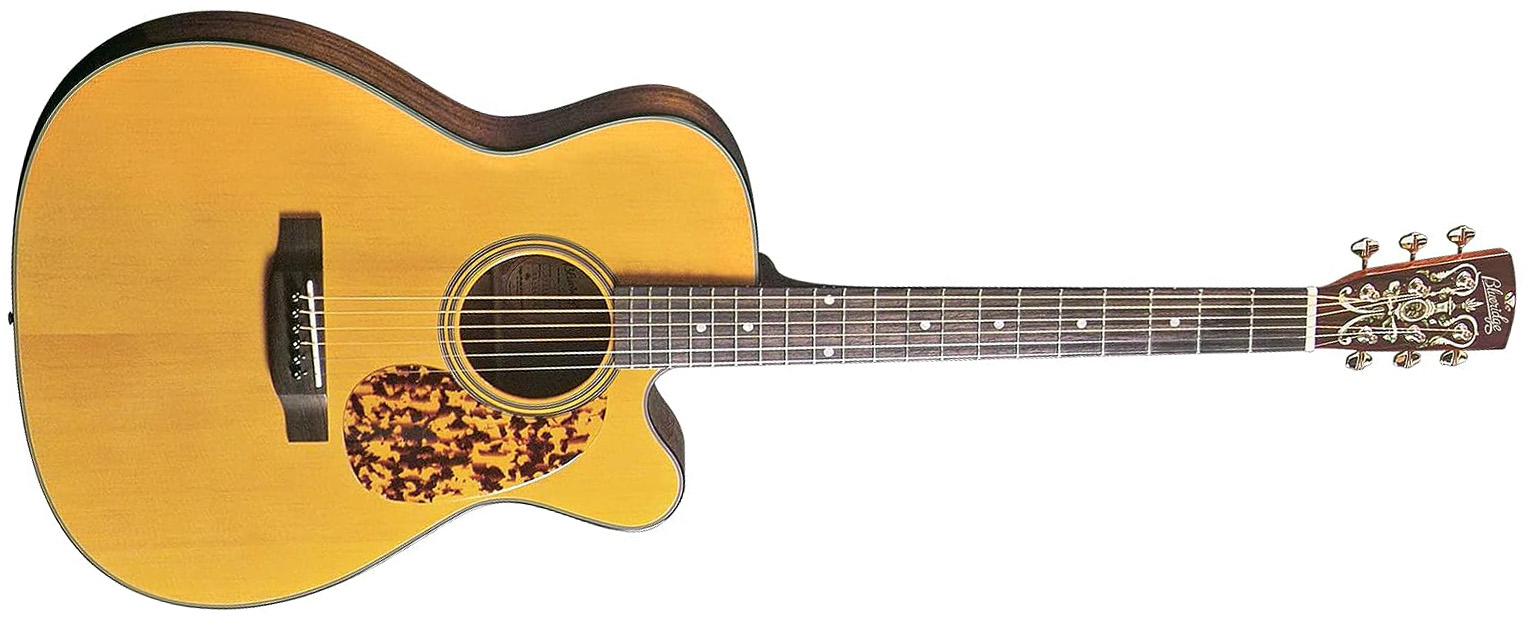
Meet the Blueridge Electro 6 String Acoustic-Electric Guitar, designed for right-hand players, hailing from the 000 Sitka series (BR-143CE).
This instrument boasts a top made from solid Sitka spruce with scalloped braces that award a clear tone and neat articulation.
Its construction incorporates solid mahogany at the back and sides, which provides a warm and full-bodied resonance, enriching your musical experience.
Equipped with a slim mahogany neck, it ensures effortless playing while also offering enduring stability.
It features a Santos rosewood fingerboard that enables a silky-smooth playability.
The guitar is outfitted with the Fishman Presys Blend pickup system, and comes with an onboard tuner that delivers quality sound, making it great for any setting, from your personal space to the performance stage.
Every purchase comes with a sturdy, padded Blueridge logo bag, guaranteed to protect your prized possession.
In terms of its physical attributes, the guitar possesses a classic brown and yellow color scheme, a body made of wood, and the hand orientation is designed for right-handed players.
In the heart of this instrument lies the soul of a 000 14-fret guitar, considered by many musicians as the perfect body size that affords a large tone and volume in a manageable package.
Moreover, its Contemporary Series edition features solid spruce tops with parabolic, forward X-bracing, and a handy option for a cutaway model with integrated LR Baggs electronics.
- My Review
When it comes to sharp sound clarity and a rich tone, this particular Blueridge Electro 6 String Acoustic-Electric Guitar has got you covered.
Boasting a solid Sitka spruce top with scalloped braces, your notes will articulate beautifully, giving a real crispness to your performance.
This guitar does not fall short when it comes to robustness, thanks to its firm mahogany back and sides, which offer a deep, warm resonance.
Adding to its superb features, it has a slim mahogany neck that ensures a fast, easy action, which is an indispensable attribute for every passionate guitarist.
Further more, the Santos rosewood fingerboard of this guitar is not just a beauty to behold, but it ensures a silky smooth playability, a much-desired trait for anyone who appreciates a smooth glide on the frets.
Did you know this guitar also has a Fishman Presys Blend pickup system?
This system, coupled with an on board tuner, sounds exceptional, whether you’re in an intimate setting like your basement or on a grand stage with all the bells and whistles, so you never have to worry about the quality of the output.
When you order this Blueridge guitar, it comes with a sturdy, padded Blueridge logo bag, providing a safe and snug home for your new musical companion.
One potential downside I’ve considered is the environmental impact associated with the hardwood materials used in its construction.
The mahogany and rosewood, largely hailed as overharvested species of timber, could weigh heavily on the conscience of environmentally conscious buyers.
Unplugged, the guitar offers a sound that is not as resounding as other models.
It was noticed while switching from a dreadnought, which usually provides more depth in its sound.
Nonetheless, the guitar holds the promise of an improved sound quality with age since it is made from solid hardwood.
Few cracks and damages reported within the first few months of use might pose a concern, although it may vary depending on the environment and the level of care provided to the instrument.
I still consider the Blueridge Electro 6 String Acoustic-Electric Guitar to be a worthy investment for guitar enthusiasts.
- Pros:
- Improves sound with age.
- Fast and easy action.
- Great electronic capabilities.
- Cons:
- Potential durability issues.
- May sound good only when amplified.
- Possible overharvested woods used.
My final verdict is that the Blueridge Electro 6 String Acoustic-Electric Guitar is an excellent choice for both professionals and enthusiasts alike.
Its solid Sitka spruce top with scalloped braces, along with a solid mahogany back and sides, not only provide clean articulation and a crisp tone, but also a robust, warm resonance.
The guitar’s Slim mahogany neck offers fast, easy action and inherently long-lasting stability, making it a pleasure to play.
Furthermore, the integrated Fishman Presys Blend pickup system with on-board tuner ensures top-notch sound quality on stage or in your practice room.
Considering its price range, build quality, and great sound – I highly recommend it to any guitarist looking to upgrade their instrument.
Taylor T5z Classic Acoustic-Electric Guitar
Versatile, high-quality acoustic electric guitar with rich tones.
This acoustic-electric guitar offers an earthy, vintage character with its mahogany top and fast, fluid playing due to its compact body, 12″ fretboard radius and jumbo frets. It comes with a three-pickup configuration facilitating versatile playability, featuring five-way switching and onboard tone controls. Notable features include Small Diamond inlays, nickel hardware, and a satin classic mahogany finish, shipping in a T5z gig bag.
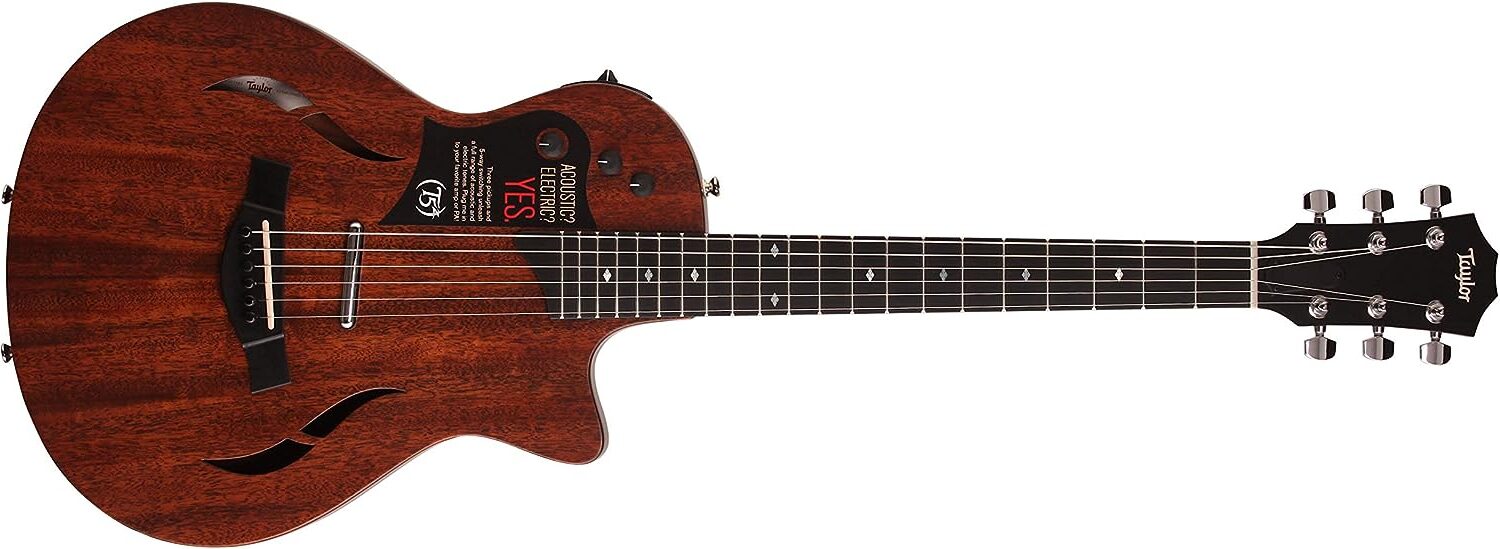
The Taylor T5z Classic Acoustic Electric Guitar Natural showcases an alluring blend of old-world charm and modern elegance.
Boasting a smooth natural finish, the body of this guitar is crafted from tropical mahogany, and is complemented by a sapele back and sides.
Its neck, made from durable sapele, supports a fretboard of the same tropical mahogany as the body.
To add a touch of finesse, the body is adorned with neat black binding, and standardized T5z bracing fortifies its structure.
This piece from Taylor comes in a Satin Classic Mahogany color, accentuating its stylish aesthetics.
The guitar’s tone and acoustics are powered by a three-pickup configuration, including an acoustic body sensor, a concealed neck humbucker, and a visible bridge humbucker.
With a five-way switching and onboard tone controls, it offers you a highly configurable electric/acoustic guitar playing experience.
The guitar design includes jumbo frets and a compact body size relative to the original T5, translating to a fast, fluid playing experience.
Nickel hardware, distinctive small diamond inlays, and a right-hand orientation complete its robust profile.
Finally, the product comes with a T5z gig bag for easy transportation.
- My Review
Having had the pleasure of experiencing the Taylor T5z Classic Acoustic Electric Guitar, I must confess that its versatility is indeed impressive.
With its tropical mahogany top wood and sapele back/side wood, this guitar not only offers a rustic aesthetic appeal but also stands out in terms of its tonal quality.
I particularly relished the fluidity and comfort of the 12″ fretboard radius and jumbo frets, which significantly facilitates string bending.
Being able to switch seamlessly between an acoustic body sensor, a concealed neck humbucker, and a visible bridge humbucker, accorded me an incredible variation of electric and acoustic tones, a feature I found truly delightful.
What struck me as singularly distinctive about this guitar, however, was its astounding lightweight construction, which ensured that even long hours of performance did not put needless strain on my shoulders and back.
I also appreciated the guitar’s composition featuring a H guitar pickup configuration and nickel string material type, offering an ensemble of rich and diverse sounds.
Note, however, that for those partial to playing on lighter gauge strings, the ones recommended for this guitar might come off as a tad stiff.
Whilst dazzling in most respects, I must highlight a few concerns I had with the guitar’s acoustic setting, which, in my opinion, could have been less jangly sounding.
Given its price point, I also expected a slightly superior gig bag quality, although this is, admittedly, more a matter of personal preference.
The satin classic mahogany color of this guitar contributes to its vintage and earthy character, adding an aesthetic feature that I have come to admire greatly.
Its compact body design aids in convenience, especially for on-the-go performances or practice sessions.T5z bracing ensures stability and compliments the guitar’s overall durability.
Customer service from Taylor, the brand behind this instrument, has always been commendable and a reason you’d want to invest in this option.
The Taylor T5z Classic Acoustic Electric Guitar, with its unmatched versatility, agreeable design, and sound quality improvements, left an indelible impression on me.
I wouldn’t hesitate to recommend this piece to any committed guitarist, owing to its sound quality, construction and driving focus on user experience.
It might require a pretty penny, yet for the handiness and tonal versatility it provides, I firmly believe it’s worth the investment.
- Pros:
- Very versatile instrument.
- Excellent customer service from Taylor.
- Comfortable for long playing sessions.
- Cons:
- Battery life short.
- Poor acoustic setting sound.
- Expensive for some users.
My final verdict is that the Taylor T5z Classic Acoustic Electric Guitar Natural is a fine piece of craftsmanship tailored for versatile musicians.
The combination of Tropical Mahogany and Sapele woods provides an earthy character and a visually pleasing aesthetic.
The unique three-pickup configuration and five-way switching boost your control over the guitar’s tone and sound output, increasing its utility for both electric and acoustic performances.
Its compact body design, a fast neck with jumbo frets and a 12″ fretboard radius ensures a comfortable and fluid playing experience.
In short, it is a high-quality, versatile, and stylish guitar perfect for both amateurs and professionals.
Takamine Pro Series 3 New Yorker Acoustic-Electric Guitar
Full-bodied voice in a compact guitar.
Despite its small size, the Pro Series 3 New Yorker Acoustic-Electric Guitar from Takamine delivers a clear, full-bodied sound characterized by an airy sweetness. It boasts a solid cedar top with hand-scalloped X bracing, a sapele back, rosewood fingerboard, and state-of-the-art electronics for a unique acoustic experience. Additional features include a split-saddle bone bridge, gold tuners with amber buttons, and a renowned CT4B II preamp system with a built-in tuner.
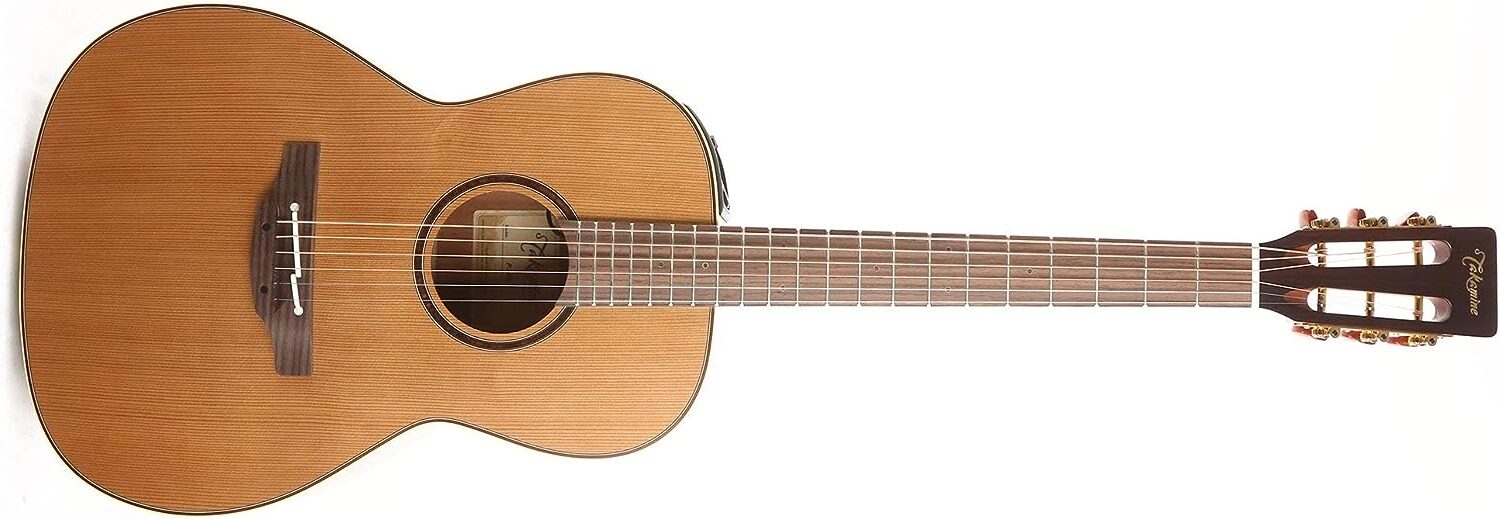
You’re looking at the Takamine Pro Series 3 New Yorker Acoustic-Electric Guitar. What’s immediately noticeable about this guitar is its relatively small size, but don’t let that deceive you.
This guitar isn’t just petite, it’s equipped with a clear and robust sound, rendering it quite captivating.
It exudes an irresistible airy sweetness and unique tone, paired with slick handling and cutting-edge built-in electronics for an altogether exceptional acoustic experience.
A distinctive feature of the guitar is its solid cedar top, intricately crafted with hand-scalloped X bracing, ivory binding, and a dark purfling that frames a stunning concentric-ring rosette decorated with wood marquetry.
Contrary to common under saddle pickups, the Takamine design uses a dozen times the element mass which results in accurate and complete guitar tones even at high sound pressure levels.
It’s also important to note that the CT4B II preamp is specifically designed for simplicity of use and tone purity featuring three graphic EQ tone control bands, a volume control slider, and a built-in chromatic tuner.
With a back made of solid sapele, a mahogany neck, and a rosewood fingerboard adorned with wood dot-in-dot inlays, this guitar is a premium choice for any music enthusiast.
The Natural finish and gold tuners with amber buttons enhance its elegant appearance, while the inclusion of a case ensures it stays safe and secure.
- My Review
I must express my bewilderment at the compact size of the Takamine Pro Series 3 New Yorker acoustic-electric guitar.
Despite its petite dimensions, it delivers an amazingly full-bodied voice with an undeniably delightful airiness.
The unique and airy sweetness that it exudes perfectly complements the guitar’s distinctive character.
Even when played at high sound pressure levels, its Palathetic pickup ensures the delivery of accurate acoustic tones, which I found impressive.
The clear, balanced tone is courtesy of the six individually shielded piezo-electric elements in the pickup casing.
The craftsmanship represented by the guitar’s solid sapele back and sides, coupled with the solid cedar top, truly stands out.
The hand-scalloped X bracing and ivory binding, with its dark purfling, showcase the guitar’s artistic design.
Admiring its aesthetic appeal further, you will notice the intricate wood marquetry rosette that encircles the sound hole.
Furthermore, the Takamine guitar features an adjustable bridge system that ensures faultless intonation and excellent acoustic coupling to the top.
The gold tuners with amber buttons not only look good, but also contribute to the overall functionality of the piece.
Its distinctive piezo pickup configuration enhances the quality attributes of the guitar and helps in producing a rich and harmonious acoustic tone.
If you are in search of smooth use and state-of-the-art onboard electronics, you will absolutely appreciate this guitar.
From my experience, the CT4B II preamp system is easy to operate and offers pure, uncompromised sound.
The unique split-saddle design of the Takamine guitar ensures a stable performance and a precise and smooth transition between the notes.
However, I would advise a potential buyer to take into consideration their preference for a parlor-style guitar as the smaller body might not be to everyone’s liking.
The guitar’s natural satin finish, in my opinion, adds to its traction and prevents slippage while handling.
Nevertheless, I must point out that the guitar’s rosewood fingerboard may need some getting used to, especially for newcomers to the guitar scene.
The Takamine Pro Series 3 New Yorker Acoustic-Electric Guitar in a natural color scheme, has captured my attention with its unique specifications and exquisite craftsmanship.
It’s a charming little instrument that packs a big punch in terms of acoustic quality, making it a lucrative buy for anyone passionate about music.
- Pros:
- Compact size, full-bodied voice.
- State-of-the-art onboard electronics.
- Rich harmonic content.
- Cons:
- No significant negatives were found.
My final verdict is that the Takamine Pro Series 3 New Yorker Acoustic-Electric Guitar Natural is an excellent choice for guitarists of all levels.
It delivers a full-bodied voice and an irresistible airy sweetness despite its diminutive size.
Top-notch features like the solid cedar top with hand-scalloped X bracing, the unique Takamine split-saddle bone bridge, and the CT4B II preamp system enhance the overall playability and tone.
Its outstanding construction and state-of-the-art onboard electronics make it a great value for the price.
Godin A6 Ultra Natural Electro-Acoustic Guitar
Versatile tone with superior North American craftsmanship.
This high-quality guitar, crafted in North America, boasts a Double-Action Truss Rod and a Honduras Mahogany neck. With electric/acoustic tone possibilities, it also features an EPM under saddle transducer. Made of cedar wood and two-chambered silver leaf maple, it offers right hand orientation and a fixed rosewood guitar bridge system.
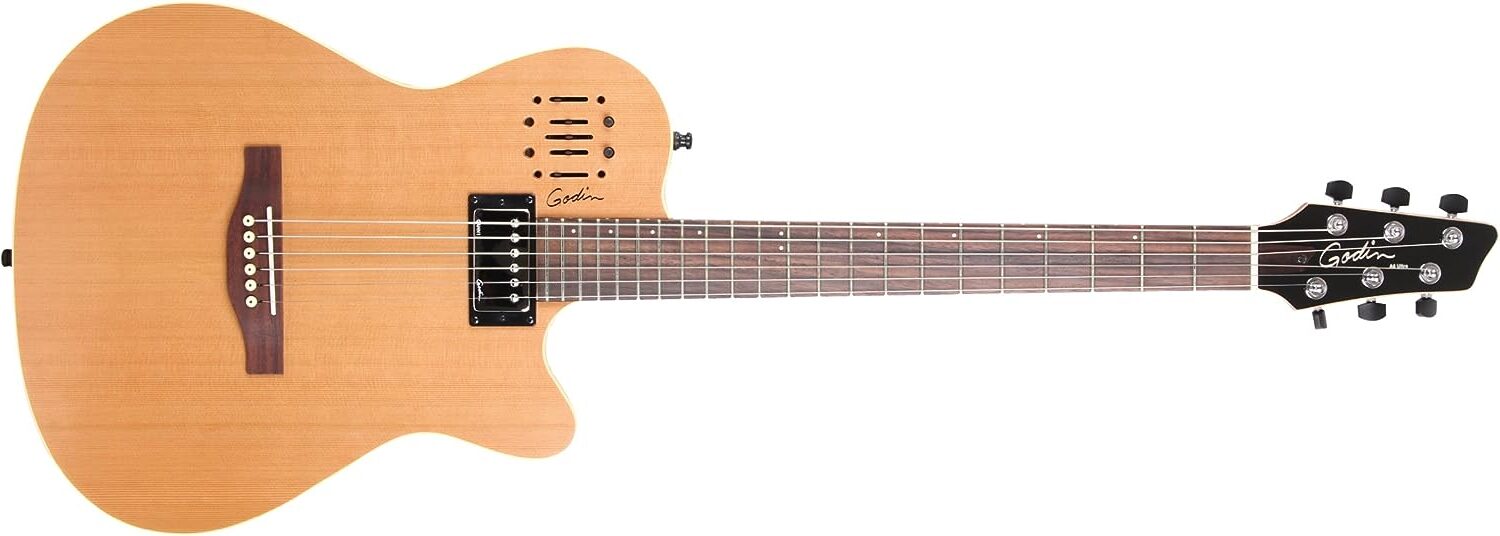
This guitar, made by Godin, is called the A6 Two-Chambered Electro-Acoustic model and its finish is a stunning, natural hue.
A stand-out feature of this guitar is its North American craftsmanship, a mark of quality and durability.
Uniquely, it features a Double-Action Truss Rod, a key component in maintaining the straightness of the neck and offering an easy way to adjust string height.
The neck is made of top-grade Honduras Mahogany, which adds to the richness of its sound, providing a warm tone that artists deeply appreciate.
You can enjoy both electric and acoustic sounds, thanks to its amazing tone possibilities.
It includes an EPM under saddle transducer, which plays a key role in producing a sweet and balanced acoustic sound when plugged in.
The top of the guitar is crafted from cedar wood, an acknowledged choice for performing artists due to its warm song projection.
The back is formed of two-chambered silver leaf maple, famed for its sonic qualities, combines with the cedar top to deliver an impressively resonant sound.
A finely crafted rosewood bridge system is utilized, and the guitar is designed for right-handed players.
Sporting an ‘H’ guitar pickup configuration, this guitar can produce high-quality electric guitar sounds that musicians crave and audiences love.
- My Review
I must admit, I was initially attracted to the unique design of the Godin A6 Two-Chambered Electro-Acoustic Guitar.
The craftsmanship is interesting, combining elements of both acoustic and electric guitars into one versatile instrument.
Now, the instrument’s durability was one of the first things that stood out to me as I had the guitar in hand.
The North American make found in this model gives it a solid, reliable built, thereby ensuring prolonged use.
Constructed with a Honduras Mahogany neck, this ensures a comfortable, balanced grip during play, which I particularly appreciate.
Interestingly enough, the instrument comes with an EPM under saddle transducer, and the blend of electric and acoustic tones showcases the guitar’s wide-ranging sonic capabilities.
Suffice to say, the diverse sound possibilities is a feature that would greatly appeal to guitarists aiming to expand their musical range.
Nonetheless, I found the guitar’s sound without any amplification to be decent, albeit not quite as robust or deep compared to a full-sized cutaway.
This does indicate however that the true potential of this model lies in its electronic use.
The double-jack system allows for customizable amplification, letting you either blend the systems using single line out, or separate the two using different amplification for each.
As for the guitar strings used, Godin’s preferred ones are the electric jazz (.012 .052), which might feel a bit thicker for some, not ideal for those preferring speed necks.
Sure enough, it does take a bit of getting used to, but once you’ve got the hang of it, it adds significantly to the overall playing experience.
Using the instrument, I found its lightweight body to be a refreshing change from regular solid body guitars.
The volume and tone controls were located at the top corner, a placement I had to adjust to initially, but over time, found it to be quite handy for swift settings changes.
It’s quite clear that the overall combination of materials used here, ranging from cedar wood and mahogany, to rosewood for the fretboard, contributes to the instrument’s unique sound and playing experience.
Despite all its merits, there were a few challenges I faced with this model, one of them being a noticeable buzz around the first three frets.
This was a minor setback, but it did affect the playability of the instrument, and considering the price, I would have expected a smoother, practically seamless performance.
Hence, what’s clear is this Godin model, while offering a beautifully unique sound range and versatility, could do with some improvements, particularly in the physical build and the initial setup of the instrument.
- Pros:
- North American made.
- Good for blend of sounds.
- Lightweight and versatile.
- Cons:
- Wood seems thin and fragile.
- Initial setup issues reported.
- May face issues with frets.
My final verdict is that the Godin A6 Two-Chambered Electro-Acoustic Guitar is a high-quality and versatile instrument.
Its North American manufacturing and Honduras Mahogany Neck speaks of its utmost quality.
The unique blend of electric/acoustic tone possibilities makes this guitar a superb choice for versatile musicians.
Furthermore, its body and back material, coupled with the EPM under saddle transducer, offers great sound projection and tonal clarity.
This guitar is well worth the investment for its stellar features and unmatched quality.
Eastman DM1 Gypsy Jazz Guitar Natural Acoustic Guitar
High-quality Eastman Gypsy Jazz Guitar with adjustable bridge.
The guitar boasts a rosewood body, neck, and fretboard with an adjustable bridge system. Detailed features include a flat neck profile, ladder bracings, painted logo, pearl dots inlay, and nickel strings. It also comes with a padded gig bag and a truss rod wrench for maintenance, ensuring a lasting musical experience.
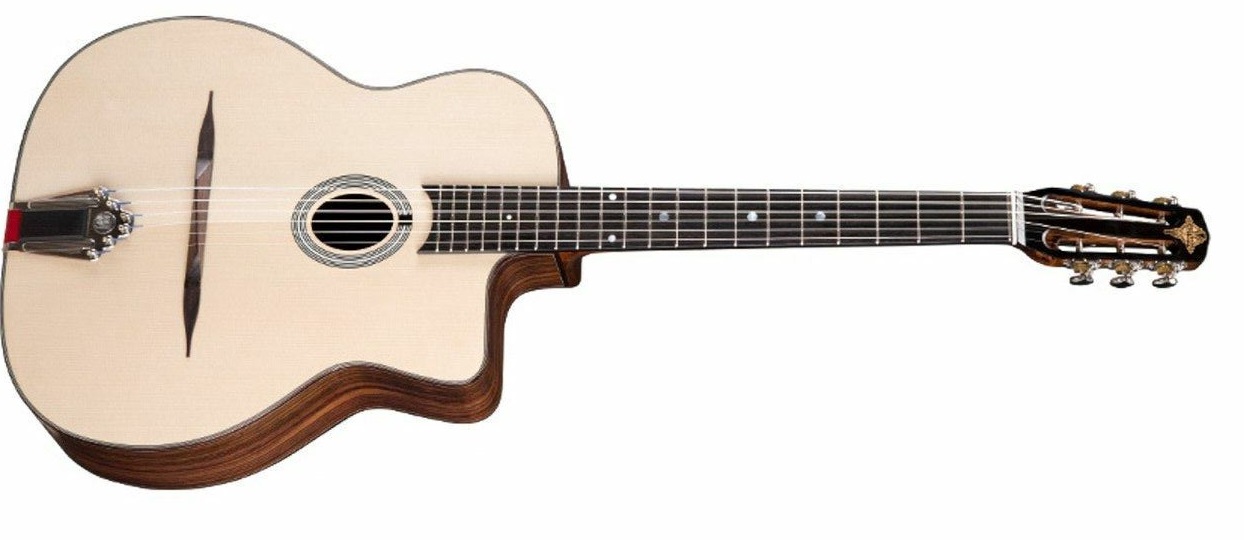
The is Eastman DM1 Gypsy Jazz Guitar in a classy natural finish.
Its discovering feature is its brand, which is Eastman, a well-known name in the world of music instruments.
What stands out about this particular model is the white color, which provides a contrast to the rosewood material used in the construction.
Speaking of materials, they are top-notch. Rosewood is used for the top, back, neck, fretboard, and body of the guitar.
The strings are made of nickel material, renowned for its clarity and brightness of sound.
Furthermore, the guitar features an adjustable bridge system, making it adaptable to different playing styles.
On a more technical note, the scale length of this model is 670 millimeters, a common standard among guitars.
There’s more to the specifics. The neck of the guitar is made of maple, and it boasts an ebony fingerboard with a flat neck profile.
Additional features include a bone nut, ladder bracings, a classic rosewood mustache bridge, laminated wood rosette, top binding in rosewood, gypsy style tailpiece, and painted logo.
It even provides pearl dot inlays, white side dot color, an open pore finish for the body top and sides, nickel hardware, and D’adarrio EJ83M strings.
An important detail to note is the action height, which maintains a balance between comfort and sound, with 3/32″ on the bass side and 2/32″ on the treble side.
Last but not least, it comes with a protective padded gig bag for transport, and a 4mm truss rod wrench for adjustment.
- My Review
I found the Eastman DM1 Gypsy Jazz Guitar to be exceptional in its performance.
From the moment I first held this guitar, I was thoroughly impressed by the quality of the materials used.
The body and neck of the instrument, carefully crafted from rosewood, provide a rich and sonorous tone that I found to be quite captivating.
When I strummed the nickel strings — the audible resonance was simply delightful, proving the guitar’s superb sound quality.
I noted an ease when utilizing the adjustable guitar bridge system which is quite an asset for any guitarist.
One aspect that left me rather amazed was the careful consideration made regarding the guitar’s scale length.
At 670 millimeters, it provides the perfect balance between fret spacing and tension, making it very comfortable to play.
Moving to the appearance, the aesthetics of this instrument are simply extraordinary.
The open pore finish, accompanied by the laminated wood rosette, perfectly complements the all-white color scheme of the guitar, reflecting an elegant and classic look.
Adding more charm to the aesthetics, Eastman has incorporated pearl dot inlays and a finely painted logo.
It is also noteworthy to mention the inclusion of a padded gig bag which offers safe and easy transport of the guitar.
However, as a guitarist, I noticed that a guitar’s string holds a significant impact on its sound production.
Switching to a set of .11 Daddario strings indeed gave the DM1 Gypsy Jazz Guitar a wonderfully bright and articulate tone.
Moreover, the Gotoh SE780 tuners proved to be extremely stable, adjusting and keeping the tuning with ease.
I must say, Eastman has put a great deal of thought into designing this guitar, ensuring it fits ideally into a musician’s hand for both casual strumming and professional performance.
There are very minute points that I might critique, but they are far outweighed by the exceptional sound, playability, and aesthetics of the Eastman DM1 Gypsy Jazz Guitar.
The Eastman DM1 Gypsy Jazz Guitar carries itself with a dignity and allure that only enhances its enchanting sound.
- Pros:
- High quality and sound.
- Excellent finish, action, and neck.
- Awesome bridge and fret finish.
- Cons:
- Strings may need replacing.
My final verdict is that the Eastman DM1 Gypsy Jazz Guitar Natural is a fantastic instrument packed with features that cater to all jazz enthusiasts.
The use of rosewood in its construction gives it a unique, warm tone.
Its adjustable guitar bridge system allows for personalized playability, while the supplementary padded gig bag makes it convenient for travel purposes.
Finally, the premium nickel tuners guarantee the longevity of this guitar, making it a worthwhile investment.
The Eastman DM1 Gypsy Jazz Guitar Natural is a reliable and high-quality choice for all musicians, particularly those passionate about jazz music.
Fender FA-115 Dreadnought Acoustic Guitar
Quality Fender sound with valuable accessories included.
This acoustic guitar has a dreadnought body with a natural gloss finish spruce top, basswood back and sides, plus a 20-fret walnut fretboard. The complete pack comes with picks, a strap, spare strings, and a gig bag. The kit provides excellent value for beginners and also includes a 90-day subscription to Fender Play for access to online lessons.
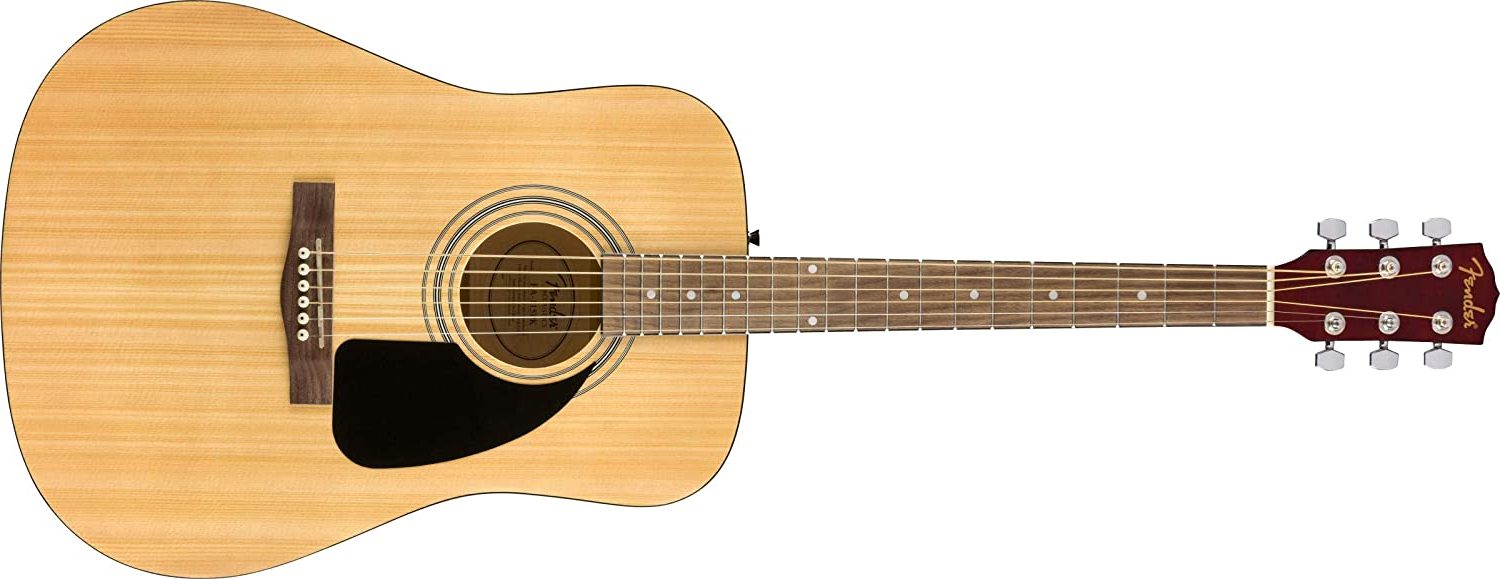
This Fender FA-115 product pack is precisely what you need for a fantastic entry into the world of music.
It houses a dreadnought acoustic guitar that is renowned for its impressive, rich sounds.
The guitar demonstrates a shiny natural finish on its spruce wood top, beautifully complemented with a distinctive “X”-bracing and basswood for its back and sides.
You’ll enjoy playing on a comfortable, 20-fret walnut fingerboard.
It also carries a sturdy walnut bridge, featuring a compensated saddle that aids in maintaining intonation.
The package is not just about the guitar; it includes a protective gig bag, a convenient strap, handy picks, and extra strings, everything you need to start playing the instrument right away.
The guitar’s neck is made from Nato wood, while its fretboard and bridge system material are of walnut type.
The strings are primarily bronze—ideal for a bright, clear tone.
Designed for right-hand orientation, the FA-115 hails from the iconic brand, Fender.
What’s more, the pack also provides a complimentary 90-day subscription to Fender Play, giving you access to an enormous amount of online lessons.
This whole ensemble is a comprehensive offer, focusing on value and sound quality, poised to initiate anyone’s musical aspirations off to a great start.
- My Review
Approaching the Fender FA-115 Dreadnought Acoustic Guitar Pack, the first aspect that catches attention is its sleek, black finish.
Its dreadnought body style stands out as unique and robust.
As I explored the material elements, I found the glossy spruce top, adorned with X-bracing, and the basswood body compelling for its quality and construction.
The richness of the Walnut fingerboard and bridge became apparent as my fingers danced across the 20 frets.
I appreciated the labels of Walnut wood for the fretboard and bridge as it signifies a durable and good-quality guitar, ideal for long-term use.
The included gig bag, picks, strap, and spare strings demonstrate the brand’s commitment to providing customers with a complete package.
Switching my attention to the brand, the name ‘Fender’ instantly resonates with high quality and excellent craftsmanship in the music industry.
The guitar’s body material, composed of spruce and mahogany woods, is a classic combination that enhances its sound quality.
The standing combination of a nato wood neck and a walnut wood fretboard further enhanced playability and held the potential for a variety of sounds.
The bronze string material used in this guitar is known for its bright, clear tone and long-lasting durability.
Geared towards right-handed players, it addresses a major segment of potential guitarists, however, it is slightly off-mark for those left-handed.
The guitar’s walnut bridge system is a testament to its solid construction and assures a good resonance.
What makes this pack particularly suitable for beginners is the free 90-day subscription to Fender Play.
Practical lessons are often the best ways to learn, and getting a head start with hundreds of online lessons is an opportunity that shouldn’t be passed up.
Despite the many positives, I noticed a few downsides to this product too.
Its primary issue lies in its durability, which may leave much to be desired in the long run.
Additionally, without the promise of reliable warranty support from Fender, this concern is only amplified.
For those investing in their first guitar, this might pose as a potential hurdle in their musical journey.
It may not affect those who view it as a starter guitar, but for those envisaging a long-term relationship, it may not be the most ideal choice.
- Pros:
- Sleek, black design.
- Perfect for beginners.
- Includes various accessories.
- Cons:
- Not durable.
- Poor warranty support.
- Considered a throwaway product.
My final verdict is that the Fender FA-115 Dreadnought Acoustic Guitar Pack is an excellent investment for beginners.
Its quality construction using spruce and mahogany wood ensures the guitar’s durability and rich sound.
The addition of a gig bag, picks, a strap, and a spare pack of strings, makes this pack extremely valuable for starters.
Moreover, the free 90-day subscription to Fender Play further enhances this offer, by providing access to hundreds of online lessons.
This guitar pack is wonderful value for money and well worth considering for nascent guitarists.
D’Angelico Premier Tammany LS Acoustic-Electric Guitar
No-frills acoustic guitar prioritizing warm tone and comfort.
The Tammany LS acoustic-electric guitar boasts a comfortable body size with a slim C-shape neck and warm, balanced tone across all six strings. The design features a shallower upper bout depth and tapered shoulders for remarkable comfort and warmth. It comes with a D’Angelico preamp and tuner for easy on-stage amplification, EQ control, and an LED tuner.
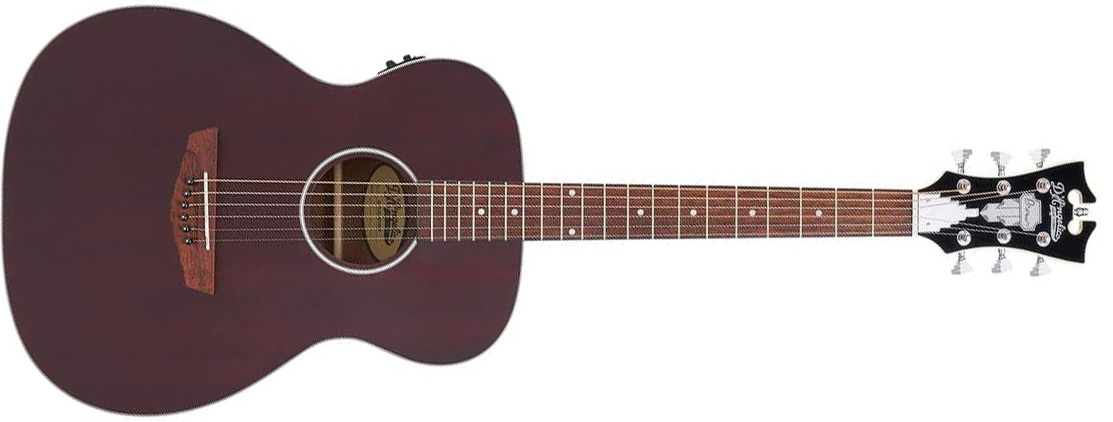
The D’Angelico DAPLSOMSTWCP Premier Tammany LS Acoustic-Electric Guitar, a Gear Hero Exclusive, is a no-nonsense acoustic offering with a focus on lush tones and ease of play for musicians of all skill levels.
It comes complete with a gig bag and a standout feature is its pre-installed D’Angelico preamp and tuner, designed to reproduce the guitar’s natural tone faithfully. This allows for easy on-stage sound adjustment and fine tuning, thanks to the built-in EQ, volume control, and an LED tuner.
What contributes to the unique, warm tone of the guitar is its slightly shallower upper bout depth and tapered shoulders, which offer excellent comfort for the player as well.
This guitar’s body size, slim C-shape neck profile, and the materials used (laminated mahogany for the body, stainless steel for the strings) ensure that the instrument is pleasantly comfortable and straightforward to use for every player.
Boasting a right-hand orientation, and a fixed bridge system, the Tammany LS houses six strings that produce a clear, balanced tone, making it an ideal pick for solo performers or singer-songwriters.
An additional detail worth noting is the guitar’s beautiful Trans Wine color that enhances its overall aesthetic appeal.
Ultimately, the Premier Tammany LS is a no-fuss, all-in-one package for musicians who value warm, balanced sound and effortless playability.
- My Review
Looking at the D’Angelico Premier Tammany LS Acoustic-Electric Guitar, one immediately notices the stunning design and the trans wine color, which add a distinct aesthetic value to the instrument.
The guitar features an impeccable Mahogany Laminated body material that lends it a beautiful visual appeal and durability.
Having played it for several hours, I am happy to note that the guitar highlights a sensationally warm and balanced tone across all of its six stainless steel strings.
The secret to this balanced, singing tone is the innovative D’Angelico Preamp and Tuner, designed to translate and amplify each guitar’s natural tone.
Equipped with Piezo pickup configuration, the D’Angelico Premier Tammany LS delivers crisp sound replication, immersing players in a captivating acoustic experience.
The guitar offers serious comfort for all players due to its unique body design, slightly shallower upper bout depth, and tapered shoulders, which also contribute to the warmth of its tone.
This comfort is further enhanced by the notably comfortable body size and a slim C-shape neck profile.
Being a musician myself, I immensely appreciate the built-in LED tuner onboard that optimized my performance on-stage, turning it into a simplified experience.
I find the Gig Bag included in the package to be a nice touch, offering convenience and protection to the instrument.
However, the electronics could be improved for better sound, especially for recording purposes; a minor tweak that doesn’t overshadow the guitar’s overall performance.
Swapped out for an Elixir Acoustic Phosphor Bronze with NANOWEB coating, the guitar’s strings introduce a rich and more vibrant resonance.
For players who prefer right orientation, this guitar hits the mark with its fixed bridge system, enhancing its playability.
Despite being a no-frills acoustic option, this D’Angelico guitar stands out, prioritizing warm tone and serious comfort for all players.
It’s safe to say that this guitar has managed to blend style, sound and cost effectively, creating an excellent choice for both bedroom musicians and singer-songwriters.
Contrary to some experiences, I didn’t encounter any rash issues upon prolonged use, perhaps indicating variability in individual experiences.
If you’re seeking a guitar that sounds as impressive as it looks, the D’Angelico DAPLSOMSTWCP Premier Tammany LS Acoustic-Electric Guitar is a fantastic choice.
- Pros:
- Great sound quality.
- Play comfort and ease.
- Affordable price.
- Cons:
- Poor preamp quality.
- Mediocre tuner.
- May cause allergic reactions.
My final verdict is that the D’Angelico DAPLSOMSTWCP Premier Tammany LS Acoustic-Electric Guitar, Trans Wine is an excellent choice for any guitarist looking for superior comfort and warm tone.
The onboard preamp and tuner that are included offer convenience for amplified performance and are a great inclusion.
The comfortable body size and slim C-shape neck profile make it a pleasure to play, particularly for longer sessions.
The mahogany laminated body material and stainless steel strings contribute to a sound that is warm, balanced, and clear across all six strings.
Sheeran By Lowden S03 Acoustic Guitar
Versatile, high-quality acoustic guitar with unique design.
This versatile acoustic guitar features a solid cedar top, Indian rosewood 5-piece back and sides, and an ebony fretboard, providing a high-quality playing experience. Hailing from Northern Ireland, it uniquely combines playability, tone, and aesthetic appeal. It comes with an LR Baggs EAS VTC pickup and a corresponding branded gig bag, ensuring its safety during transportation.
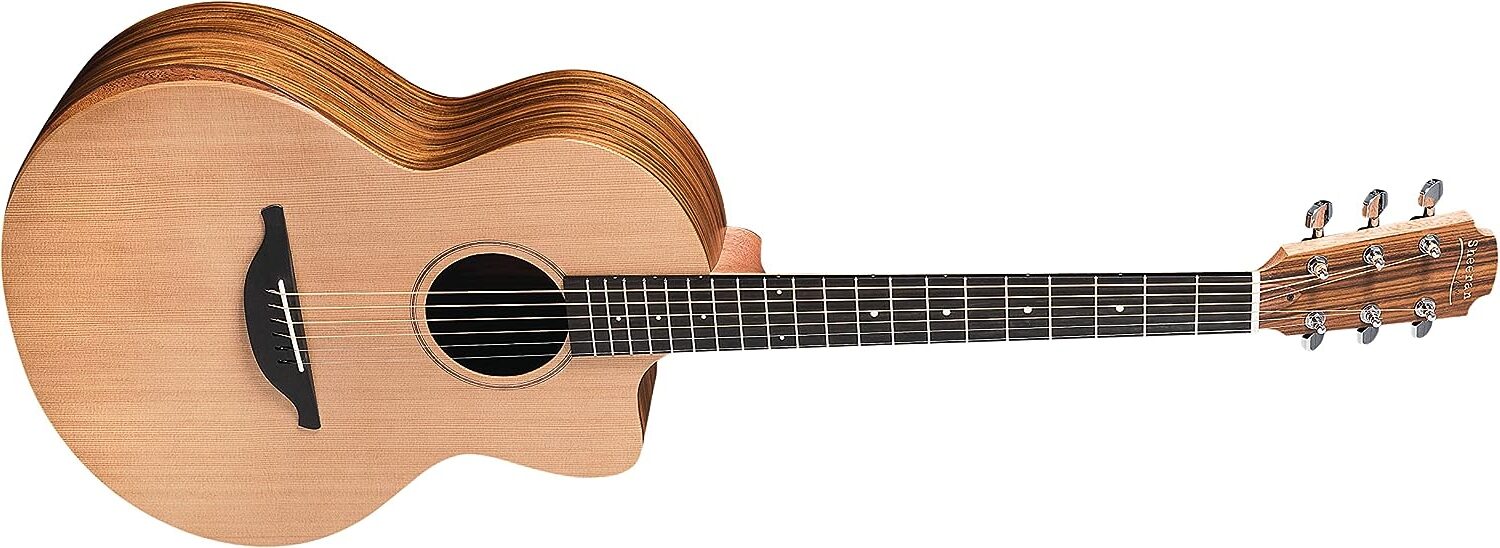
The Sheeran By Lowden S03 Acoustic Guitar comes with a matching, branded gig bag. It is designed to be an all-purpose tool for discerning musicians.
The guitar boasts a solid cedar top enhancing the rich and full sound it offers, while the Indian Rosewood, composed in a 5-piece set, forms the back and sides of the guitar, adding to its aesthetic and sound quality.
It’s designed with a cutaway and a Soundbox Bevel that is not only uniquely stylish but also enhances playability.
The guitar’s neck is carved from Mahogany, and the Ebony fretboard, accompanied by a 24 4/5″ scale length, completes its superior construction.
Aiding the guitar’s impressive dynamics is an LR Baggs EAS VTC Pickup, concealed for a clean aesthetic.
The Sheeran Guitar is coated in a natural color, that flawlessly combines with the different types of wood used in its design.
The string material for this guitar is Phosphor Bronze, chosen for its longevity and vibrant tone. Keep in mind as well that this guitar is designed for right hand orientation.
Ed Sheeran’s personal range of guitars are handcrafted in Northern Ireland, with each model being custom designed by George Lowden to maximize playability, tone, and accessibility.
The brand takes great pride in using materials and techniques from Lowden Guitars, including a 5-piece construction and hand-carved voicing. Their passion lies in helping musicians around the world find their perfect instrument and create fresh music every day.
- My Review
As an avid player and guitar enthusiast, I took pleasure in immersing myself in the Sheeran By Lowden S03 Acoustic Guitar.
My first impression of the guitar focused on the sheer beauty of its design, embracing an elegant, classic aesthetic with a natural color, which, in my opinion, significantly enhances the overall visual experience.
Upon closer examination, it’s evident that this instrument is a product of high-quality craftsmanship that employs premium materials.
Solid cedar is used as the top material which not only adds considerable durability, but also induces a vibrant, warm tone that resonates through each strum.
Moreover, the Indian Rosewood 5 piece back and sides not only contribute to the aesthetics but also significantly impact the guitar’s tonality.
Completing the guitar’s build is the mahogany neck and ebony fretboard, combining to provide a comfortable, premium feel in every session.
Probably the most notable feature is the well-integrated LR Baggs EAS VTC Pickup.
It broadens the guitar’s capabilities, allowing for amplification without losing its acoustic integrity or altering its natural sound characteristic.
Indeed, it’s as if this instrument resonates with Ed Sheeran’s passion for music, through the sound it produces and its overall design.
As for its playability, I find the 24 4/5″ scale length very accommodating to a range of playing styles.
The soundbox bevel and cutaway design, though seemingly minor add-ons, provide extra comfort for extensive playing sessions.
I find the addition of a Sheeran By Lowden branded gig bag to be a thoughtful touch, underscoring the brand’s focus on accessibility and user experience.
One aspect I’d like to further address is the instrument’s suitability for right-handed players, as this could potentially limit the demographic of guitarists able to fully enjoy this fine instrument.
To wrap up, beyond its visual appeal, the Sheeran By Lowden S03 Acoustic Guitar proves to be a versatile package that offers a beautiful balance between craftsmanship, playability, and sound quality.
It’s evident that a lot of thought and effort has been put into this guitar’s creation making it a worthwhile option for discerning players.
- Pros:
- Custom designed for playability and tone.
- Included LR Baggs EAS VTC Pickup.
- Comes with Sheeran By Lowden branded gig bag.
- Cons:
- No significant negatives were found.
My final verdict is that the Sheeran By Lowden S03 Acoustic Guitar is an exceptional product.
The versatility and excellent construction materials, including a solid cedar top and Indian Rosewood 5 piece back & sides, make it a fantastic choice for both novice and experienced players.
Also worth mentioning is the thoughtful inclusion of a padded gig bag in the package – an extra which will certainly be appreciated by travelling musicians.
The capacity for tone customization provided by the LR Baggs EAS VTC Pickup ensures pleasing and varied sounds whether played acoustically or amplified.
Finally, the knowledge that this product is handmade in Northern Ireland adds an air of authenticity and exclusivity to this exceptional instrument.
Godin 5th Avenue Kingpin P90 Jazz-Style Acoustic-Electric Guitar
Vintage-style guitar with modern playability and tone
This electric guitar offers vintage jazz style, crafted from Canadian Wild Cherry for the arched top, back, and sides. Its features include silver leaf maple neck, rosewood fingerboard, and a single-coil Godin Kingpin P90 pickup enhancing sound projection and volume. The package includes an accessory set with a strap, tuner, capo, picks, and a polishing cloth.
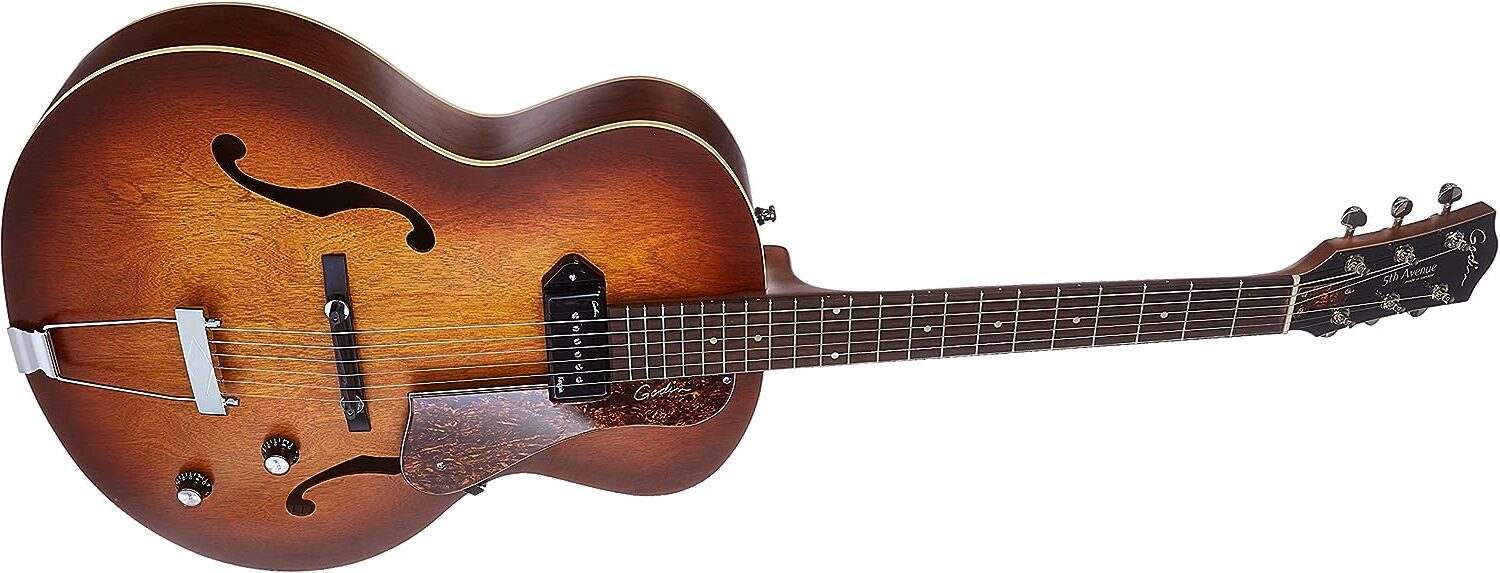
The Godin 5th Avenue Kingpin P90 Jazz-Style Acoustic Electric Guitar Bundle in a distinctive Cognac Burst color brings you a touch of nostalgia with characteristics of a 1950’s acoustic archtop guitar, cleverly melded with modern elements for today’s guitarists.
The bundle does not only encompass the guitar but also includes a free accessory pack loaded with a strap, a Snark Clip On Tuner, a capo, picks, and even a polishing cloth.
Produced in North America, the body of the guitar exhibits a distinctive, molded arched top and back which has been masterfully crafted from Canadian Wild Cherry.
It has a silver leaf Maple neck and a Rosewood Fingerboard which certainly enhances its aesthetic appeal and functionality.
Noteworthy is the inclusion of an Adjustable Tusq Bridge by Graphtech to suit varying preferences.
The special prototype Godin Kingpin P90 Single-Coil Pickup bestowing an unmistakable vintage tone with a clear sound and an edgy undertone.
The guitar is constructed with a right-hand orientation system and uses a Graphtec Adjustable Tusq Bridge set up.
Finally, the guitar’s finish is absolutely captivating; a unique Custom Polished Finish evokes the vintage French polish of the 19th century, which along with the cream binding earns it an unbeatable rustic charm.
- My Review
From my personal experience with the Godin 5th Avenue Kingpin P90 Jazz-Style Acoustic Electric Guitar Bundle, there’s a lot to unpack when it comes to this guitar.
Sporting a distinctive Cognac Burst aesthetic, I have to say the guitar is visually stunning.
Its color is complemented beautifully with a body crafted in wild cherry, hailing from North America.
Beyond its exterior beauty, one of its key aspects that truly caught my attention was the mold of its body—an arched top, back, and sides all out of a wild cherry.
This goes hand in hand with the fact that this guitar incorporates a silver leaf maple neck, giving you a comfortable playability.
The fingerboard made out of rosewood further enhances playing experience.
It’s worth mentioning that the Adjustable Tusq Bridge by Graphtech, with which this guitar is designed, increases the tonal resonance and ensures sustain.
Perhaps, what I appreciate most in this regard is the inclusion of the Godin Kingpin P90 Single-Coil Pickup, as it stands out for delivering exceptional sound quality.
Onto the sound aspect of this guitar, I was genuinely impressed.
There’s a wonderful blending of modern playability and vintage spirit that simply appealed to my ears.
What’s more captivating is its dynamically rich tone, which offers more projection and volume in the low and mid ranges—an aspect not commonly found in traditional archtop guitars.
And while the guitar is primarily made for jazz sound, it also suits styles from Alt-Country, Delta Blues, to Rock.
This versatility makes it a suitable choice for guitar enthusiasts of multiple genres.
However, no product is perfect, and I must admit I faced difficulty in keeping the guitar in tune for extended time.
While every guitarist’s mileage may vary, I personally think the neck is quite fat which could prove bothersome to some players, particularly those with smaller hands.
Furthermore, the bridge shape might dig into the palm and affects playability over time, which I found uncomfortable after an hour of continuous play.
My main issue arises when playing it unplugged, where the sound tends to be tinny.
The acoustic sound doesn’t come off as rich as I’d like, instead, it felt more akin to an electric guitar being played unplugged.
Despite a few quirks, overall, this guitar scores big with its visual appeal, build quality, and most importantly, its uniquely resonant sound.
I would safely say it’s an excellent addition for every guitar lover’s collection.
- Pros:
- Great sound and playability.
- Quality made North American guitar.
- Visually beautiful with vintage feel.
- Cons:
- Has tuning stability issues.
- Sound can be tinny unplugged.
- Neck might be uncomfortable for some.
My final verdict is that the Godin 5th Avenue Kingpin P90 Jazz-Style Acoustic Electric Guitar Bundle is an impressive instrument.
The sound quality both acoustically and electrically is superb, making this guitar perfect for a wide range of music styles from Alt-Country to Rock.
Not only does it deliver on playability, but its construction from Canadian Wild Cherry and Silver Leaf maple contributes to durability and unique tonal qualities.
With the inclusion of a high-quality Accessory Pack and the Godin Kingpin P90 single-coil pickup, I confidently state that this bundle offers excellent value for money.
Whether you’re an expert musician or a beginner, this guitar is a worthy investment.
Blueridge Guitars BR-341 Acoustic Guitar
Crisp tone, durable design, and striking aesthetics.
This acoustic guitar has a solid Sitka spruce top with mahogany back and sides for clear articulation and warm resonance. The slim mahogany neck offers durability and easy action, complemented by a premium ebony fingerboard. Additionally, the purchase includes a sturdy, padded Parlor Guitar Gig Bag for safe storage and transport.
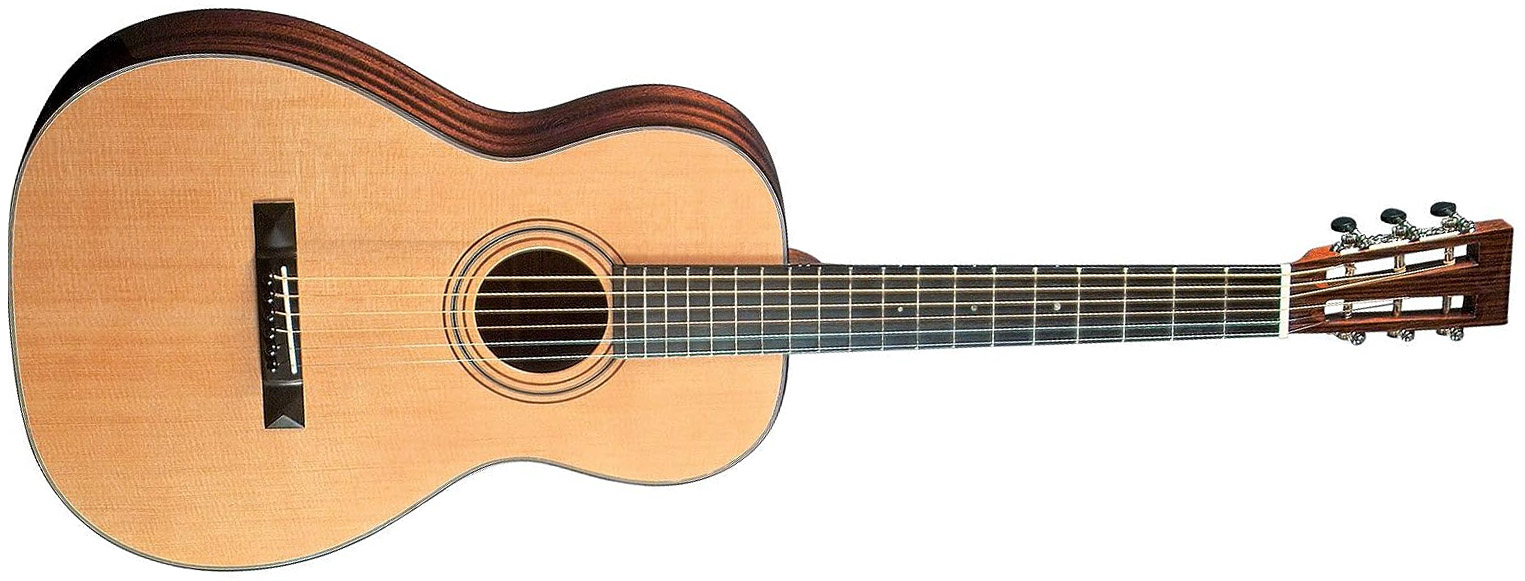
The Blueridge Guitars 6 String Acoustic Guitar, specifically designed for right-handed individuals, exhibits a classic ivory finish.
It’s engineered with an incredibly solid Sitka spruce top, combined with scalloped braces, and this combination ensures absolutely clear articulation, along with a bright, sharp tone.
Constructed with solid mahogany for both its back and sides, this design contributes towards a rich, warm resonance.
The guitar incorporates a slim mahogany neck which facilitates quick, effortless action, and includes inherent stability ideal for lasting use.
Complementing the overall aesthetics, the premium ebony fingerboard is not only highly durable, but is also visually appealing.
For protection, every guitar from the Historic Series Parlor includes a padded Blueridge Logo ProTour BV-1302 Parlor Guitar Gig Bag.
The guitar displays colors of brown, ivory, and black and is part of the reputable Blueridge Guitars brand.
The top material is spruce while the body and the neck are made out of Sitka-Spruce and mahogany, respectively, and both the fretboard and string materials are rosewood and phosphor bronze, respectively.
Finally, the guitar was inspired and developed in the creative and prosperous aftermath of the Great San Francisco Quake of 1906 and has stood the test of time and quality, evident in its high value amongst collectors, in particular, those interested in parlor style guitars.
- My Review
I thoroughly enjoyed exploring the rich auditory experience the Blueridge Guitars 6 String Acoustic Guitar (BR-341) provides.
Boasting a solid Sitka Spruce top, this guitar delivers clean articulation and a clear, crisp tone that truly makes each note come alive.
Surprisingly, despite its relatively small footprint, the solid mahogany back and sides were powerfully robust, producing a warm resonance that seemed to linger after each chord progression.
When it came to the actual quality of play, I found the slim mahogany neck to be especially helpful.
Offering fast, easy action, this feature provided a long-lasting stability that truly facilitated intricate finger placements and swift chord transitions.
The premium ebony fingerboard not only added a touch of undeniable class to the instrument’s physical appearance, but it also contributed to the overall durability of the guitar.
Thanks to the sturdy, padded Blueridge Logo ProTour BV-1302 Gig Bag that is included, the guitar was saved from any potential damages or dents while transporting.
However, as a right-handed musical enthusiast, I did find the guitar’s hand orientation to be slightly restrictive.
Accompanying the instrument’s construction and sound, I admired the historical appreciation and reverence the series showcases.
The Historic Earthquake Series Parlor style, for instance, pays homage to a flourishing period of creativity and prosperity in America after the San Francisco earthquake of 1906.
On the downside, I noticed that the frets were not as well-dressed as they could have been.
There were a few instances where my thumbs and index finger were nicked when sliding up and down the neck of the guitar, making the experience rather uncomfortable.
Despite this issue, I still find the Blueridge Guitar to be a commendable instrument, and would indeed recommend it.
Though it may require a little extra setup and attention to detail, it truly shines as an acoustic guitar that provides an exceptional musical experience.
The sound quality it provides deserves mention as it was less than satisfactory in my opinion, seemingly lacking the multifaceted depth I usually look for in an acoustic guitar.
However, considering all its features and quality, I believe the Blueridge BR-341 is an investment that can truly enrich one’s musical journey.
- Pros:
- Attractive good looks and build.
- Crisp tone and warm resonance.
- Included sturdy, padded gig bag.
- Cons:
- Possibility of high action setup.
- Risk of fret problems.
- Potential delivery damage.
My final verdict is that the Blueridge Guitars 6 String Acoustic Guitar is a high-quality and value for money instrument.
Its Solid Sitka spruce top with scalloped braces offers clear articulation and a crisp tone, making it a fantastic choice for both beginners and seasoned guitarists.
The robust, warm resonance from the solid mahogany back and sides emulates vintage instruments while the slim mahogany neck offers easy action and stability.
The added bonus of a sturdy, padded ProTour BV-1302 Parlor Guitar Gig Bag ensures safety and convenience.
The BR-341 model is not just a guitar but a piece of musical history, tying craftsmanship to the spirit of creativity and prosperity, making it a valuable addition to any collection.
Gretsch G100CE Synchromatic Cutaway Acoustic-Electric Guitar
Versatile Gretsch guitar with top-notch materials and controls.
This electric guitar boasts a Gretsch pickup, separate volume and tone controls, and a chromatic tailpiece, lending to its high-quality performance. It is made with a spruce top, maple body and back, a maple neck, and a rosewood fretboard. Right-handed musicians will appreciate its guitar bridge system and black color.
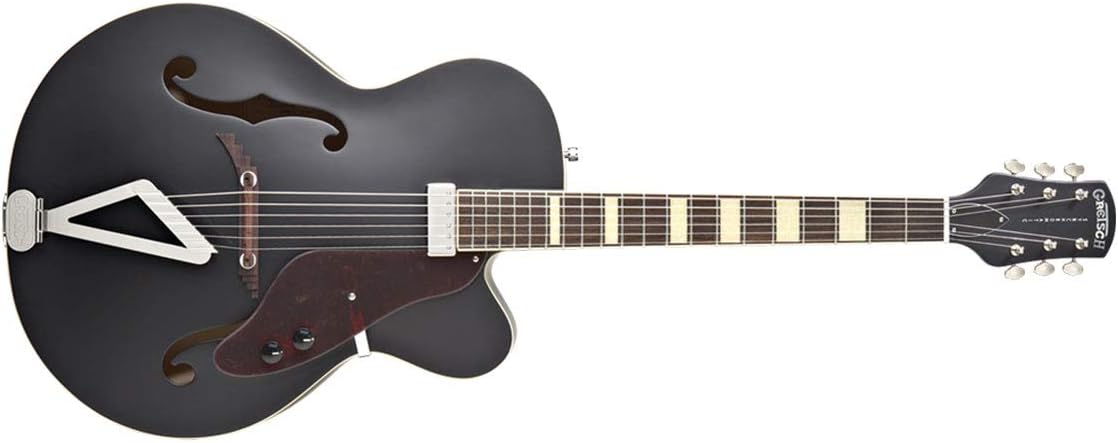
If you’re into music, you may appreciate the Gretsch G100CE Synchromatic Cutaway Acoustic-Electric Guitar. The design is done in a distinguished shade of black, that shouts classic.
Hand orientation is designed for right hand users, so it would suit most guitarists.
The guitar’s body, back, and neck are all made from maple, a robust and tonal friendly wood.
The crown jewel of the guitar is definitely the Gretsch pickup. It enables the guitar to produce rich, sound resonance irrespective of the volume.
You would appreciate the separate volume and tone controls, they would offer you full command over the sound output.
Ever critical to any guitar is the material of the fretboard. This one flaunts a rosewood fretboard, widely recognised for its ability to produce warm tones.
In addition, the top of the instrument is made with spruce, a material known for its sound quality and durability.
To complete the features, there is the chromatic tailpiece and a carefully designed guitar bridge system, which comes under the model GR2515831506.
The Guitar carries the brand name of Gretsch, a reputable name in the world of stringed instruments.
As a whole, the Gretsch G100CE Synchromatic Cutaway Acoustic-Electric Guitar is not just another guitar. It’s a well designed, beautifullycrafted music instrument
- My Review
After spending ample time with the Gretsch G100CE Synchromatic Cutaway Acoustic-Electric Guitar, I can confidently say, it’s certainly a standout among its peers.
My first impression was drawn by its appealing black finish, providing a classic yet modern aesthetic, and the high quality materials used in its construction.
The body, neck and back are all made of high-grade maple which is reputed for its tonal qualities, while the fretboard is constructed with rosewood which offers a beautiful contrast to the body and provides a silky texture under your fingertips.
I was particularly taken with the chromatic tailpiece, a feature from which this guitar gets its distinct Synchromatic name.
Why is a chromatic tailpiece significant? Well, it allows for a range of different tunings exposing the guitarist to a whole new universe of soundscapes.
Even more unique is the presence of a Gretsch pickup which is known for its warm, full-throated and robust sound.
Performance wise, this guitar is just perfect for both jazz and blues aficionados as noted by the smooth delivery of the classic hollow body sound.
It’s marvelous how the tone can be precisely sculpted using the individual volume and tone controls.
Plugged in, the guitar sounds rich and lively, but what pleasantly surprised me was how well it performed acoustically.
Even when played unplugged, it retains a remarkable resonance and depth, courtesy of its well-tuned acoustic properties.
The neck of the guitar is particularly remarkable, its smooth and glossy texture allows for effortless chord transitions and slick solos.
Being a right-handed guitar, it provides a comfortable grip and ease of use to right-handed players.
Another noticeable feature is the guitar’s bridge system, a certain GR2515831506, which helps maintain the guitar’s tuning stability.
While the Gretsch G100CE Synchromatic Cutaway Acoustic-Electric Guitar ships relatively in tune, I did need to give it a quick tune-up on arrival for optimal playability.
Truly, as a professional or beginner musician, one can appreciate the value this guitar offers in contrast to its price point.
There’s no doubt, the Gretsch G100CE Synchromatic Cutaway Acoustic-Electric Guitar is a distinctive instrument layered with finesse, top-notch sound quality, and a vintage appeal that’s hard to resist.
- Pros:
- Smooth, glossy neck for easy sliding.
- Great for jazz and blues.
- Good acoustic and electric performance.
- Cons:
- No significant negatives were found.
My final verdict is that the Gretsch G100CE Synchromatic Cutaway Acoustic-Electric Guitar is a quality instrument with considerable versatility.
Its Gretsch pickup and separate volume and tone controls allow for a wide range of sound options, perfect for musicians seeking flexibility.
Maple construction and a rosewood fretboard contribute to its sturdy feel and enduring lifespan.
This is a high-performance guitar that genuinely stands out among other products in its category.
What Makes a Good Acoustic Guitar for Jazz Music?
A crucial aspect when considering an acoustic guitar for jazz is the instrument’s tonality.
Specifically, for jazz, the guitar must have a balanced sound with clear articulation and rich, warm tones.
This implies that the guitar should have the capacity to produce intricate details in the music, preserving the integrity of complex jazz harmonies.
Remember that jazz is a genre known for its spontaneity and improvisation, and the guitar should have the flexibility to accommodate this aspect.
Moreover, an excellent jazz guitar should have a comfortable playability.
This means that the guitar should feel good in your hands and be easy to maneuver.
The neck should be smooth and responsive, facilitating quick chord changes and finger movements that jazz often calls for.
Furthermore, the action, which is the distance between the strings and the fretboard, should be low enough and string tension should be light enough to promote smooth playability without compromising the quality of sound.
In a jazz guitar, the hardware can significantly impact sound quality.
This involves the tuning machines, bridge, and the nut, all of which should be made from high-quality materials.
Remember, hardware of top quality doesn’t merely enhance the overall aesthetics of the guitar but greatly contributes to its resonance and sustain.
This is a prime factor in really bringing out the rich sounds and tonal nuances inherent in jazz music.
The quality of the guitar’s construction is another vital factor.
High-quality acoustic guitars built with precision will deliver a more defined and consistent sound.
Construction quality also contributes to the instrument’s durability and longevity.
Therefore, consider guitars made by reputable manufacturers who pay close attention to detail and craftsmanship.
Lastly, the finishing touches of the guitar also play a role.
This particularly applies to the guitar’s finish, aesthetic appeal, and attention to design details.
Although visual appearance does not directly influence the sound, it does affect the player’s personal experience and attachment to the instrument.
Ultimately, high-quality finishing touches can make the instrument so much more enjoyable to play and can be a source of pride and satisfaction for the player.
While keeping these factors in mind, there’s no one-size-fits-all when it comes to choosing a jazz acoustic guitar.
Each musician may have personal preferences based on their individual style and the sound they are aiming for.
What feels and sounds good to one player may not necessarily resonate with another.
The key is to take the time to assess different guitars, preferably in person, and make a choice based on how well the instrument aligns with your personal requirements and style.
What Are Typical Features in a Jazz Acoustic Guitar?
Jazz music, renowned for its complexity and emotional depth, puts unique demands on the instruments used to create it.
Understanding the typical features of an acoustic jazz guitar can help musicians find the ideal instrument for their needs.
Firstly, jazz guitars often have a robust and rich tonal character.
This is because jazz music typically features a broad spectrum of tones, from deep and resonant bass notes to crisp and sparkling high tones.
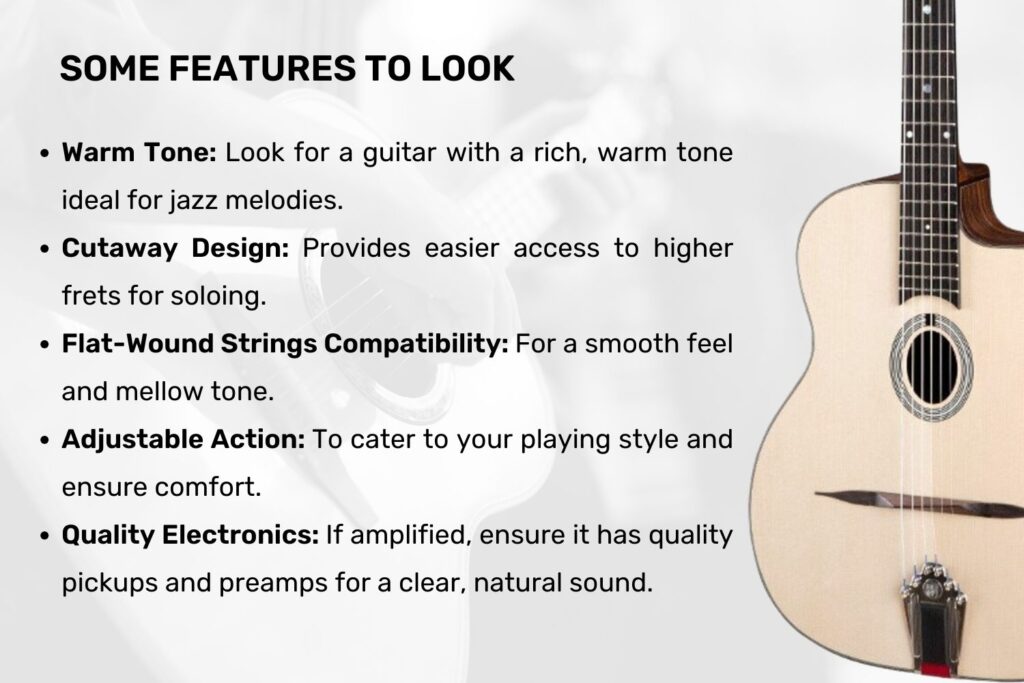
An excellent acoustic guitar for jazz will, therefore, be capable of reproducing these diverse tones accurately and distinctly.
To this end, many jazz guitars feature large soundboxes constructed from high-quality tonewoods.
The size and construction materials of a guitar’s soundbox significantly impact the richness and resonance of its tone.
Secondly, the neck configuration of a jazz acoustic guitar is an essential feature.
Jazz music can be highly technical, making a slim, fast neck desirable for quick chord transitions and complex runs.
Much of the typical jazz guitar sound and playing style comes from the ability to play complicated chord shapes and fast runs across the neck.
Therefore, manufacturers often offer jazz guitars with a narrower neck width and a shorter scale length.
Another standard feature in jazz acoustic guitars is having flatwound strings instead of roundwound ones.
These give a smoother feel and eliminate finger noise, resulting in a cleaner and warmer tone.
These strings are also known for their soft attack, making them ideal for jazz music’s often subtle and smooth character.
Many jazz guitars are equipped with an embedded pickup system.
Capturing the instrument’s acoustic sound and amplifying it, this feature enhances the guitar’s versatility, especially in band or ensemble settings.
Lastly, a distinctive feature in many jazz guitars is a single cutaway design in the body.
This design element allows the musician increased access to higher frets, which is especially useful due to the often complex and extended melodic lines played in jazz.
Despite these standard features, it is essential to note that finding the perfect jazz guitar is largely a subjective process.
Attributes like tone quality, comfort, and aesthetics of the guitar are all individual preferences that define one’s choice.
The right guitar can bear significant weight in a musician’s expression of jazz, making this an important consideration.
While these features make a general guide, it is in the hands of the player that the guitar finds its true voice.
How to Choose the Right Acoustic Guitar for Jazz?
Choosing an acoustic guitar for Jazz is an intricate task that demands careful consideration of multiple factors.
The first factor that might impact your decision is the sound.
The uniqueness of Jazz music is its broad spectrum of tones, therefore the guitar must have a diverse range of tones, and convey warm and mellow sounds while also having a clear, bright sound on higher notes.
Another critical aspect to consider is the guitar’s body type.
Every body type creates a distinct sound, a larger body typically results in a louder and more resonant sound while a smaller body usually produces a more concentrated tone that is excellent for fingerpicking.
Playability should also not be neglected in your decision-making process.
Consider the guitar’s neck shape and width, the distance from the strings to the fretboard, and the size of the frets as these elements can influence your comfort and technique.
A significant factor in the selection of a Jazz guitar is also the instrument’s wood type.
The three main woods used in acoustic guitars are mahogany, rosewood, and maple, each of which provides a distinct tonality, resonance, and sustain that can cater to different Jazz styles.
String selection between nylon and steel is a similarly vital factor.
Jazz players favor nylon strings for their warm and nuanced sound, ideal for fingerstyle jazz, while steel strings produce a clear and vibrant tone, suitable for strumming and hybrid picking styles.
The guitar’s bracing pattern and the presence of a cutaway may also affect your preference.
The cutaway design allows easier access to the higher frets while the bracing pattern can influence the instrument’s sound and resonance.
Furnished with the aforementioned factors, listening to different guitars and experimenting with a broad variety will help you find the tone, feel, and style that suits your Jazz music the best.
You may also consult with more experienced Jazz musicians, guitar technicians, or teachers who can guide you into making a more informed decision.
Ultimately, trust your ears and intuition as follow what sounds and feels best for you and your style is the best choice.
Remember that acquiring a guitar is a nuts and bolts process that extends beyond mere aesthetics, and give the process the due diligence it deserves by keeping these criteria in mind.
What Wood Type Is Best for Jazz Acoustic Guitars?
The selection of wood type used in the construction of an acoustic guitar plays an intrinsic role in the final sound the instrument will produce.
Various woods have distinct tonal characteristics, which can be critical in creating the versatile and smooth sound required for jazz music.
Consider, for instance, the wildly popular Spruce wood.

Renowned for its clear, vibrant sound, Spruce is often used in the guitar tops due to its unique ability to resonate the sound clearly.
Its sound tends to get even better over time, offering a delightful aging process for the guitarist and their audiences alike.
Apart from spruce, another favored wood is cedar.
Preferred by fingerstyle players, cedar tops are loved for its warmth and immediate response, creating a comforting sound that can be perfectly in sync with the melodies of Jazz.
It is essential, however, to remember that cedar is softer and might not respond well to aggressive strumming.
Then there is mahogany – dense and heavy.
It’s often used in the making of guitar backs and sides and is famous for its concentrated, punchy tones suitable for rhythm back-up role in Jazz trios or quartets.
Another useful wood type is rosewood, noted for its rich, complex overtones and is ideal for creating a full-bodied, resonant sound, very much loved by Jazz musicians.
Let’s not forget about maple.
Maple-made guitars are identified by a bright, focused tone with fewer overtones which allow it to cut through the mix, assisting when the Jazz band is in full swing.
However, as much as the wood type is essential, it’s equally important to consider how the wood is treated and prepared during the guitar construction process.
Many high-end acoustic guitars use what’s known as tonewood.
Tonewood has been chosen, dried, and processed specifically for use in guitar construction because of its superior resonance properties.
In the end, the choice of the wood type in a guitar depends much on the player’s personal preference along with what kind of sound they are looking to produce with the instrument.
Be it the warm and deep tones of mahogany, the bright and clear notes from spruce, or the complex and full-bodied melodies that can be produced from rosewood, the ultimate goal is to create music that truly speaks to one’s soul.
Should You Opt for Steel or Nylon Strings for Jazz?
When you are selecting the strings for your acoustic jazz guitar, there are two main types to consider: steel or nylon.
Steel strings are generally noted for their bright and sharp tone, perfect for the rich melodies frequently found in jazz music.
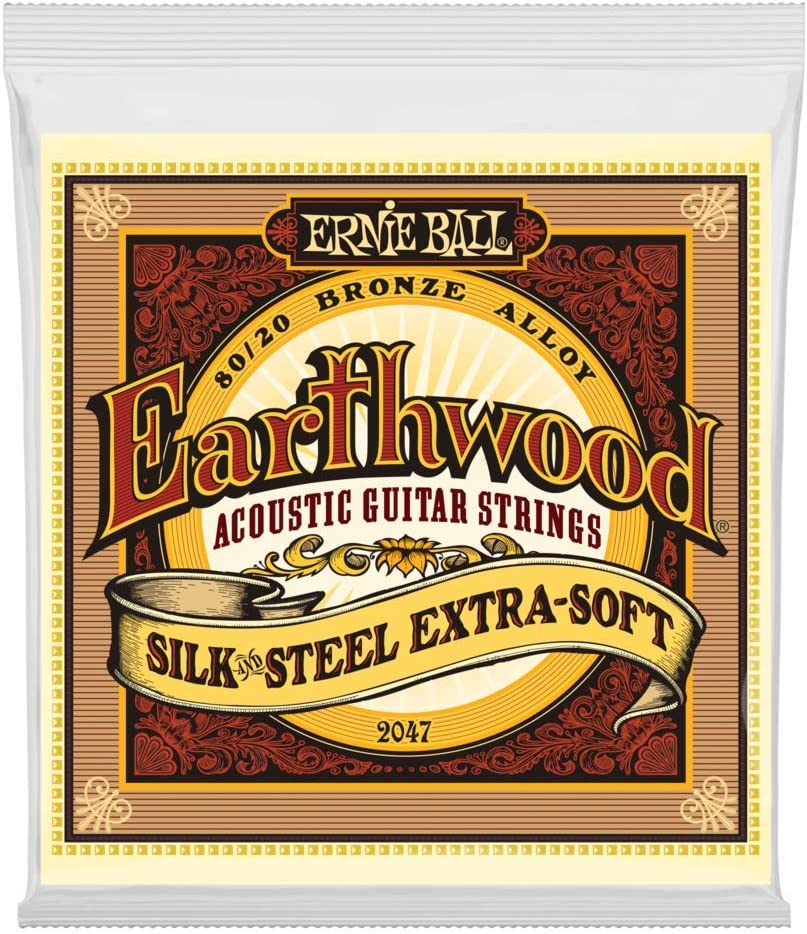
These strings can venerate a lively and vibrant sound which stands out during performances and improvisations, making them a favoured choice by many jazz musicians.
However, it is important to note that steel strings can be demanding on the fingers, especially for beginners or for those who play extensively.
They require one to develop calluses for comfortable play, and thus may not be appealing to some players.
On the other hand, nylon strings offer a softer, mellower sound that some guitarists find preferable for certain jazz styles.
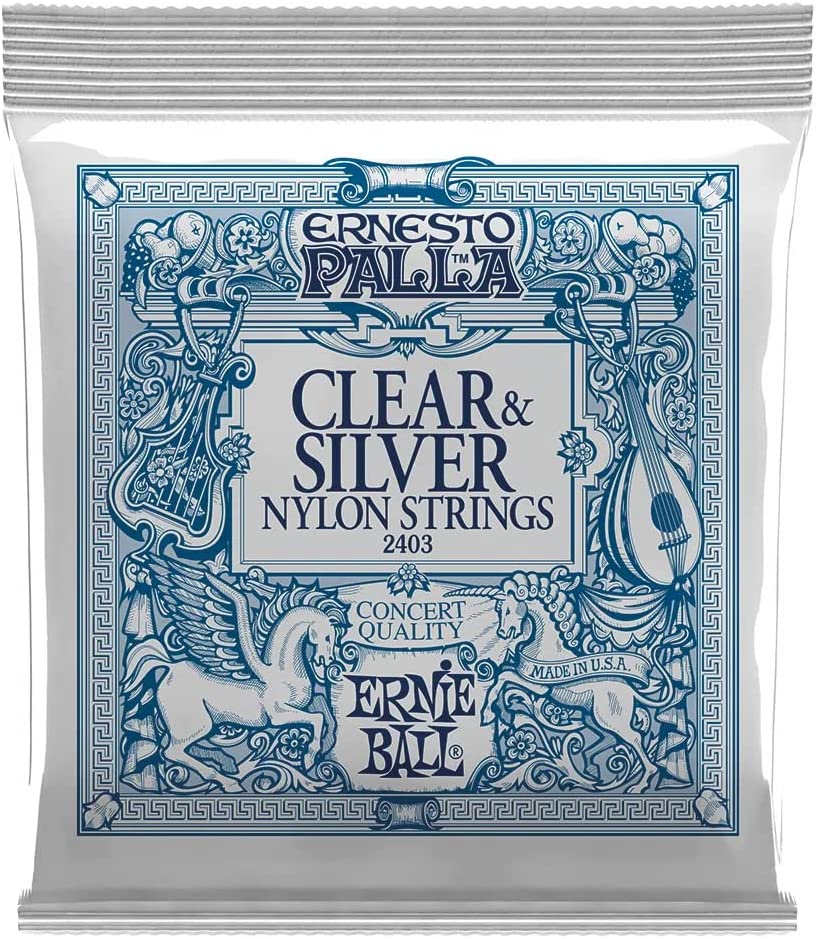
Nylon strings produce a warm and resonant tone that lends itself to intricate fingerpicking or emotive, mellow ballads found in some jazz genres.
Thus, these strings may be an ideal choice for musicians that appreciate a softer, less aggressive sound from their instrument.
One of the benefits of the nylon strings is their less strenuous impact on the fingers, making them a good option for beginners, or for musicians who play for long periods.
However, the decision between steel and nylon should also take into account the guitarist’s personal playing style and preferences.
An individual’s touch, finger pressure, and strumming technique all play a significant role in the sound that is ultimately produced from the guitar.
Hence, a person should try out different sets of strings, experimenting with both steel and nylon types, on various guitars, to find what best complements their playing attributes.
Personal comfort should also be a consideration in making this choice.
While the sound produced is of significant concern, it should not come at the expense of a guitarist’s physical comfort and ease of play.
Noteworthy as well to consider the fact that the chosen guitar strings can greatly impact the longevity of the guitar.
Using the wrong type of strings or regularly changing between steel and nylon could potentially cause negative effects on the guitar’s neck or body over time.
So, when a decision is made, one should keep up with their selection to ensure the durability and longevity of their beloved instrument.
Consulting with a knowledgeable source, such as a guitar teacher or a professional musician who plays jazz, can offer further insight into making this critical choice about strings.
They can guide one towards an informed decision based on their experiences and knowledge about the specific requirements of jazz music.
In the end, the most important thing is to tailor your instrument to your own personal style and sound preference, and that understands and complements your individual musicality.
Therefore, the answer to the question of steel or nylon strings for jazz depends largely on the specific demands of the musician and their personal style of play.
How Does Body Shape Affect the Sound of a Jazz Guitar?
The sound of any guitar, including jazz guitars, is significantly influenced by its body shape.
There is a broad range of acoustic guitar shapes – from dreadnought and auditorium to guitars with a jumbo body.
Typically, the larger the body of the guitar, the more bass response and overall volume it tends to produce.

This is because a larger body allows for greater resonance, enabling lower frequencies to vibrate freely.
A jazz player might prefer a guitar with a large lower bout and a narrower waist, known as a “Grand Auditorium” or “Orchestra” model.
Such body shapes tend to balance out the bright and deep tonal characteristics beautifully, which is a benefit when playing jazz, a genre that often demands a varied tonal palette.
On the other hand, instruments featuring smaller bodies, such as parlor or “OO” models, tend to emphasize mid-range frequencies with less resonance.
These guitars might not have the same projection or ‘rumble’ as their larger counterparts, but they excel when it comes to articulation and clarity – both essential aspects for complex jazz harmonies.
They also tend to be more comfortable to play, which can be a significant factor for guitarists who perform for extended periods.
When thinking about the body shape, it’s essential to consider other factors like the sustain and standout quality a particular model offers.
The Dreadnought, for example, is well known for producing a robust and full tone with excellent sustain.
When this is combined with the Dreadnought’s unique standout quality, it can create some powerful and resonant jazz sounds that are hard to ignore.
However, some guitars have a cutaway in their design to allow easier access to the upper frets.
Even this design feature can subtly influence the tone of the guitar, generally giving a little less bass and a little more high-mid definition, which is another aspect to bear in mind.
As always, the perfect balance will depend on the guitarist’s individual style and preferences.
It’s therefore worth trying out a variety of guitars that feature different body shapes to get a feel for which specifics might best suit the music you want to play.
Ultimately, the perfect jazz guitar should have a beautiful balance of articulation, depth and resonance, making room for the nuanced performances this genre often calls for.
The body shape of the guitar plays a great role in this, so taking the time to understand how this element can shape the sound of your instrument will undoubtedly pay off in the path towards finding the ideal jazz guitar.
How Important Is the Neck Size of a Jazz Acoustic Guitar?
The size of the guitar neck can make a significant difference in many aspects, including comfort, playability, and tonal quality.
For many musicians, the neck width can be a critical factor.
The neck width affects the spacing between the strings, which may impact the ease and comfort with which you can play complex jazz chords.
If the neck is too narrow, you might find your fingers crowding over the fretboard, which can result in unwanted buzzing or muted strings.
Conversely, a wider neck means more space for your fingers to move around, aiding in playability and reducing the chance of hitting the wrong string during fast-paced jazz solos.
However, keep in mind that a significantly wider neck could cause discomfort or fatigue, especially over longer playing sessions.
Therefore, it is all about finding a balance between ease of play and comfort levels.
Besides width, the neck’s depth is also crucial in determining how the guitar will feel in your hands.
Neck depth refers to the thickness of the guitar’s neck, which can impact the overall weight and balance of the instrument.
Generally, heavier necks can add more sustain and resonance to the sound, which might be perfect for the deeper, warm tones often associated with jazz music.
However, like neck width, the depth should not be too extreme to avoid discomfort or strain on your hand and wrist.
The guitar’s neck shape or profile significantly contributes to its playability as well.
Neck profiles can range from a “C” shape, which is comfortable for most players, to a “V” shape that can rest more naturally in the palm of your hand.
The right shape and size of the neck should allow your thumb and fingers to move efficiently, which is integral for fast-paced jazz scales and complex chord progressions.
Beyond physical characteristics, the material of the neck also plays a significant role in the overall sound of the guitar.
Necks made of harder woods like Maple tend to produce a brighter, punchier tone, while those made of Mahogany yield a softer, warmer sound, which maybe more suited to the jazz genre.
The choice of neck material should also be aligned with the type of strings and body wood you choose for optimal sound mixing.
The right neck size and profile in a jazz acoustic guitar can greatly affect the playability, comfort and, ultimately, the musician’s ability to express their jazz creativity.
While there are general guidelines to follow, the best neck size will vary from one musician to another, based on their hand size, finger length, and personal playing style.
Therefore, it is essential to try out guitars with different neck sizes to find the one that feels the most natural and comfortable in your hands.
In doing so, you can ensure a smooth playing experience while creating the jazz tones that most resonate with your style.
What Is the Role of a Guitar’s Cutaway in Jazz Music?
The cutaway of a guitar is an integral part of its design that directly impacts its sound and playability, particularly in the context of jazz music.
First and foremost, the cutaway in acoustic guitars is the indented curve on the body of the guitar that allows easier access to the higher frets on the instrument.
This design feature not only contributes to the overall aesthetics of the guitar but plays a significant role in its functional capabilities as well.
The prominence of improvisation in jazz music often requires guitarists to reach for higher notes, which can be challenging without the extra space a cutaway provides.
There are two primary types of cutaways: the Venetian and the Florentine.
The Venetian cutaway features a smooth, rounded curve and is a popular choice for many jazz musicians due to its classic look and streamlined structure.
The Florentine cutaway, on the other hand, has a sharper, pointed curve that serves as a striking design feature and is favored for its enhanced access to higher frets.
One of the key advantages of a cutaway design is that it allows musicians to stretch their fingers further up the fretboard without straining their hand.
This is especially beneficial for jazz guitarists who often play complex chords and intricate solos that involve higher notes on the fretboard.
Moreover, the ability to easily reach higher frets enhances the versatility of the guitar, allowing the musician to explore a wider range of tonal possibilities.
However, it should be noted that the presence of a cutaway can sometimes impact the overall tone and volume of the guitar, particularly with acoustic models.
Due to the smaller body size resulting from the cutaway design, the sound may have a slightly reduced resonance and depth, which some musicians see as a disadvantage.
Nevertheless, many guitar manufacturers have perfected the design and construction process to minimize these potential drawbacks, allowing players to enjoy the extended fret access without significantly compromising the sound quality.
It is also worth mentioning that, in addition to the practical benefits, the cutaway design adds a visually appealing aspect to the guitar that many musicians appreciate.
Eventually, the choice to opt for a guitar with a cutaway largely depends on the individual’s playing style, their specific requirements for higher fret access, and their personal aesthetic preference.
Therefore, trying out different guitars before making a final decision is always a good idea, ensuring the selected instrument not only sounds great but also feels comfortable and enjoyable to play.
While it might not be the first design feature one thinks of when purchasing a new guitar, the impact of the cutaway on playability and tone should not be overlooked.
In the realm of jazz music, where improvisation and complex solos are often the norm, a cutaway guitar can provide the necessary tools for musicians to fully express their creativity and skill.
How Does Size Affect the Sound of Acoustic Jazz Guitars?
One of the most common factors that impacts the sound of an acoustic jazz guitar is its size.
Sound production is a key parameter that is directly related to the size of the acoustic instrument.
It’s important to understand that a larger body on a guitar typically produces a bolder, richer and louder sound.
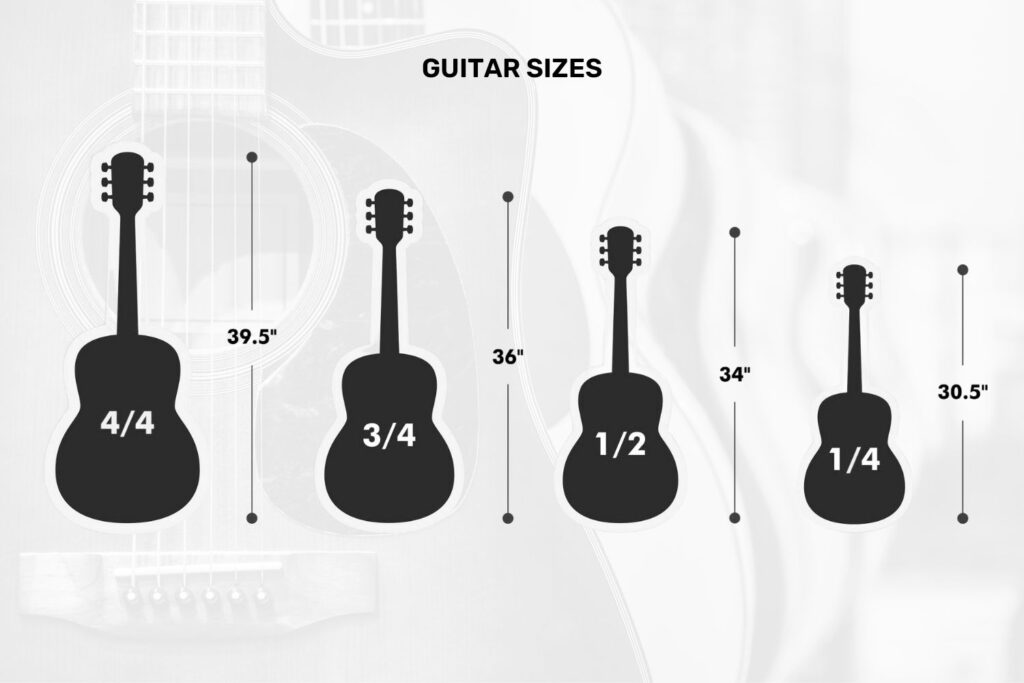
The bigger the guitar, the greater is its ability to move air inside, which translates into a more resonant and louder sound.
Furthermore, larger guitars are known to generate more bass frequencies due to their ability to produce longer wavelengths.
Essentially, the size of a guitar will alter its tonal characteristics.
In contrast to larger guitars, smaller acoustic guitars are known to generate a tighter and more focused sound.
This is because smaller body shapes have a more controlled resonance and do not emphasise the bass frequencies as much as larger guitars.
Another factor to consider is that the size of the guitar not only affects the sound, but also the playability of the instrument.
Smaller guitars tend to be easier to play, especially for those who have a smaller body size or are more comfortable with a compact playing position.
However, it is essential to remember that the size of the guitar should not compromise the sound projection and tonal qualities that are needed for jazz music.
Jazz musicians often prefer guitars that are ‘just right’ in size – not too big that it’s uncomfortable to play, and not too small that it fails to deliver the required sound projection.
While larger guitars may seem the obvious choice for a louder sound and more bass, it is not necessary that they are the best fit for jazz music.
What is more important is finding a balance where the size of the guitar complements the style of the music without compromising its playability.
The physics of sound and acoustics would suggest that larger-bodied guitars have the potential to project sound better and render a broader frequency range.
But smaller-bodied guitars have been known to produce exceptional tones, especially when played by experienced musicians.
It is therefore crucial for every guitarist to play and sense the music before deciding on the size of the guitar.
Ultimately, while the size of an acoustic jazz guitar does play a role in sound production, it is just one amongst many factors such as the kind of wood, the build quality, and the player’s technique.
So, when choosing a guitar for playing jazz music, the size of the instrument should be considered in conjunction with other attributes to ensure it meets the specific demands of the genre.
How Does a Guitar’s Bracing Pattern Impact Its Jazz Sound?
In the world of acoustic guitars, bracing pattern plays an incredibly important role in shaping the overall sound and response of the instrument, especially when it comes to playing jazz music.
The primary function of the braces is to provide structural strength to the delicate and thin top of the guitar, preventing it from warping or collapsing under the tension of the strings.
However, the design and arrangement of these braces has a profound impact on how the guitar top vibrates and moves, amplifying the strings’ vibrations to produce the guitar’s sound.
Each different bracing pattern gives the guitar a different characteristic, making it more suitable for certain styles of music.
For instance, guitars designed for jazz typically feature a bracing pattern that allows for a broad dynamic range, enabling the guitar to handle the subtle nuances and complex chord voicings that are common in jazz music.
The most common type of bracing pattern used in jazz acoustic guitars is the X-bracing, which provides a good balance between strength, dynamic range, and tonal complexity.
Bracing patterns can be tweaked and modified in numerous ways, such as by scalloping or tapering the braces, to achieve a particular sound.
A scalloped bracing pattern, for example, removes material from the braces to allow the top of the guitar to vibrate more freely, producing a brighter and more responsive sound.
On the other hand, a tapered bracing pattern gradually reduces the size of the braces from the center of the guitar towards the edges, which can result in a smoother and more mellow sound that is often favored by jazz musicians.
The bracing pattern is not a one-size-fits-all solution, but it should be chosen based on the individual player’s needs and preferences.
While the bracing pattern is a critical factor in determining a guitar’s sound, it is also important to remember that it is just one piece of the puzzle – factors like the type of wood used, the size and shape of the guitar, and the type of strings all play a significant role as well.
Ultimately, the key to finding the right acoustic guitar for jazz is to try out different options and see which one feels and sounds the best for your specific style of playing.
Certainly, understanding the role of a guitar’s bracing pattern in its resulting sound can help musicians make informed decisions when choosing their instrument, contributing to their ability to express the full richness and subtlety of jazz music.
The Bottom Line
Thorough research and genuine user reviews have informed our list of the best acoustic guitars for jazz music.
Each guitar has been chosen for its unique set of features and impeccable sound quality.
When it comes to jazz, these choices won’t leave you disappointed.
Whether you’re a beginner learning your first chords or a seasoned player looking for an upgrade, these guitars can cover your needs.
Remember that the right guitar for you ultimately depends on personal preference, including comfort while playing and the kind of sound you want to achieve.
We trust that our guide will help you make an informed decision when finding the perfect jazz acoustic guitar for you.
Sources: sweetwater.com ; guitarcenter.com ; guitarworld.com ; guitarchalk.com

More than 10 years of experience playing and writing about guitars! When not writing, I can be found strumming away some Johnny Cash tunes. Favorite all time guitar is the Gibson Les Paul. #TeamGibson

